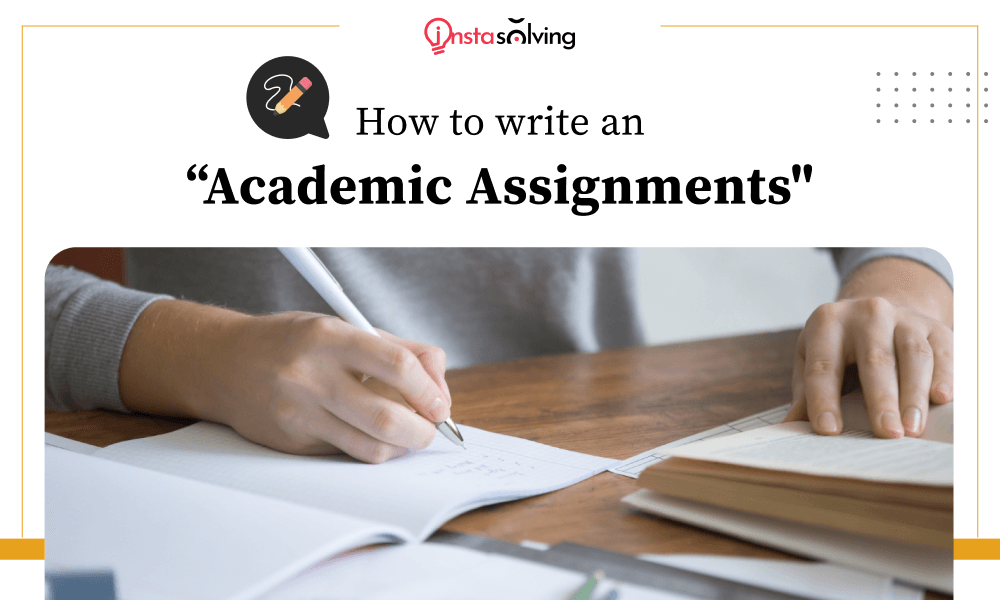

14 Proven Tips For Completing Assignments

Completing assignments can be a daunting task, but there are a few things that you can do to make the process a whole lot easier.
Are you finding it difficult to complete your assignments on time? If you’re looking for some tips to help you get organized and stay on track, you’ve come to the right place. In this post, I’ll share some helpful strategies that will make completing your assignments a breeze.
But first, let’s analyze why it’s essential that you complete your assignments on time.
Why are assignments important?
Though often met with groans and complaints, academic assignments are actually beneficial in a number of ways. For one, they force students to engage with the material on a deeper level, encouraging them to really think about what they’re learning and stay on track with their studies.
In addition, academic assignments help students to develop important research, writing and study skills that will be useful in college and beyond.
Academic assignments also give students the opportunity to receive feedback from their instructors on their work.
Assignments are a great way to increase parent engagement in learning and for students to develop a sense of responsibility.
Notably, despite its benefits, too many assignments can do more harm than good.
Too much assignments can interfere with free time and involvement in extra-curricular activities. Assignment completion may be increasingly frustrating and stressful when there are challenges with the home environment. O’Rourke-Ferrara, 1998
Why is completing assignments on time important?
Completing assignments on time allows you to fully engage with the material and understand the concepts.
Subsequently, you’ll likely earn better grades and improve your chances of success in school. Additionally, completing assignments in a timely manner will also give you a sense of accomplishment and satisfaction.
Completing assignments on time demonstrates to your instructor that you are capable of meeting deadlines. This is important in both academic and professional settings.
Plus we all know that once you start falling behind on assignments, it can be difficult to catch up.
Finally, completing assignments on time will likely improve your sleep and reduce stress levels.
According to research, completing assignments improves independence, self-discipline, and time management skills. In addition, it has been linked with better grades and academic success. planchard et al., 2015

Tips for completing assignments
So how can you make sure that you complete your assignments on time? Here are a few tips that may help:
1. Read the assignment instructions carefully
Make sure you understand what is expected of you before you start working on the assignment. Read the instructions carefully, and if anything is unclear, be sure to ask for clarification.
2. Identify why the assignment is necessary
Identifying why the assignment is necessary is an important first step for success. Acknowledging the importance of a task or goal can help you stay motivated to do the best possible work and see meaningful results.
It gives purpose to your efforts, and this in turn can help provide focus and direction, leading to better results through hard work and dedication.
Research shows that the main motivating factors for homework completion were: (1) Reinforcement: desire to learn or master the material (2) Credit (3) Extra-credit planchard et al., 2015
3. Start early to complete assignments on time
Assignments can take longer than you think, so start working on them as soon as they’re assigned. This will help you avoid last-minute stress and ensure that you have enough time to complete the assignment to the best of your ability.
4. Set goals for assignment completion
One way to stay on track with an assignment is to break it down into smaller goals. For example, if you have a research paper to write, your goal for the first day might be to choose a topic and find five sources.
Once you’ve met that goal, you can set a new goal for the next day. Breaking the assignment down into smaller tasks can help to make it feel less overwhelming, and it can also help you to track your progress.
5 . Create a schedule to finish assignments
Once you know when the assignment is due, create a schedule that breaks the work down into manageable tasks. This will help you stay on track and avoid feeling overwhelmed by the assignment.
Research shows that the most common demotivating factors for homework completion were: (1) Other commitments (2) Difficulty understanding (3) Too difficult or too long planchard et al., 2015
6. Identify the resources required for the assignment
Another important step in completing an assignment is to identify the resources that you’ll need. This might include books, articles, websites, or people you can interview. Having a list of resources will help you to focus your research and make the process easier.
7. Track your reference s when researching
As you’re doing research for your assignment, be sure to track the references that you’re using. This will save you time when you’re writing your paper and will ensure that you give credit to the sources that you’ve used.
8. Set aside uninterrupted time for assignments
Once you have a schedule, set aside time each day or each week to work on the assignment. During this time, turn off distractions like your phone and social media. This will help you stay focused and make the most of your time.

9. Ask for help if you get stuck
If you’re struggling with the assignment, don’t hesitate to ask for help. Talk to your professor, a tutor, or a friend who is doing well in the class. They can offer guidance and support that can help you get back on track.
10. Take breaks when completing assignments
Working on an assignment for long periods of time can be overwhelming and lead to burnout. To avoid this, take breaks throughout the day or week. during your break, do something that you enjoy or that will help you relax.
11. Celebrate your progress
As you complete tasks on your schedule, take a moment to celebrate your progress. This will help you stay motivated and focused. It can be something as simple as taking a break after completing a section or giving yourself a small treat.
12. Proofread your assignments
Once you’ve completed the assignment, take the time to proofread it. This will help you catch any mistakes and make sure that your work is of the best quality.
13. Submit your assignments on time
Make sure to submit your assignment on time. If you’re having trouble with this, talk to your professor or a tutor. They may be able to offer extension or help you get back on track.
14. Relax after completing each assignment
After you’ve submitted the assignment, it’s important to relax. Take some time for yourself and do something that you enjoy. This will help you relax and prepare for the next assignment.
Final words on proven tips for completing assignments
If you follow these tips, you will be well on your way to acing any assignment. Do you have any other studying or coursework tips that have worked well for you?
Drop a comment below and let me know. Best of luck in all your future assignments.
Read also: 22 Key Tips To Easily Improve Writing Skills
O’Rourke-Ferrara, Catherine. “Did You Complete All Your Homework Tonight, Dear?” Information Analyses (070) Opinion Papers (120) — Reports Research (143) 1998
Planchard, Matthew S. et al. “Homework, Motivation, and Academic Achievement in a College Genetics Course.” Bioscene: The Journal Of College Biology Teaching 41 (2015): 11-18. https://files.eric.ed.gov/fulltext/EJ1086528.pdf
Similar Posts

67 Powerful Quotes On Communication To Keep You Inspired
Are you looking for some quotes on communication that will inspire and motivate you? If…

22 Common Email Mistakes + Tips To Avoid Them
Email mistakes can lead to loss of business, or worse, a damaged reputation. It’s time…

55 Common Writing Terms, Meanings & Examples To Learn Right Now
Knowledge of common writing terms will help you produce more polished pieces that make the…

20 Golden Rules To Improve Email Etiquette
An email may be a fast, easy way to communicate with friends, family and co-workers….

22 Key Tips To Easily Improve Writing Skills
Are you having trouble receiving good reviews for your writing? If so, don’t worry –…

Rushana Greenidge-Horace
Rushana is a dynamic, knowledgeable professional with almost a decade of experience in the healthcare industry. She remains committed to promoting holistic health and wellness.
Leave a Reply Cancel reply
Your email address will not be published. Required fields are marked *
Save my name, email, and website in this browser for the next time I comment.
Professional editors. Expert processing
- Get Started
- Integrations
- Writer's workshop
- Return to dashboard
Steps and tips for completing an academic assignment
Whether you’re a university student or in secondary school, you’ll inevitably be given a writing assignment. to get good grades on writing assignments, it’s important to follow a few steps as you complete the work. to help you as you complete your assignment, we’ve listed some important steps and provided some useful tips., steps for completing an assignment.
- First, carefully read the assignment. Make sure you understand what your instructor is looking for in terms of content, formatting and structure. It’s also vital that you know when the assignment is due and start working on it well before the due date. If you have any questions about the assignment, ask your instructor as soon as possible so he or she has sufficient time to give you an answer.
- Conduct any necessary research to find information to include in your assignment. Make sure you keep notes from your research, including the publication information for each source.
- Make some notes and create a draft outline of the information you need to include in the assignment. For example, if your teacher has asked you to write about Albert Einstein’s most important accomplishments, create a chronological list of those accomplishments so you don’t forget to include any. This step also helps you organize the information so it flows clearly and coherently.
- Once your draft outline is complete, begin writing your text. Some people like to start with the introduction, which lays out your topic and explains what you’re writing about. Others like to start with the body of the document, which includes the main part of the text, and then return to complete the introduction once the body is complete. If you’re not sure which approach will work best for you, try writing the introduction first. If you struggle to come up with content, switch to writing the body of the document.
- Once your introduction and the body of the document are complete, write your conclusion, which sums up everything you’ve written about so far. Remember that the conclusion should not introduce any new information or ideas that were not discussed in the body of the text.
- If your instructor requires a list of references, create a list at the end of the document and make sure you have in-text citations to each source. Make sure to follow your instructor’s preferred style guide for the citations and references.
- Before you turn the assignment in, make sure you edit and proofread the text to ensure that there are no lingering errors in the text and that the text makes sense. It might help to have someone else look over the document to point out text that isn’t clear.
Tips for completing an academic assignment
- Before you begin writing, think about where you work best. Most of us do not work well when we are distracted by loud noises, conversations, the TV, etc. Find a quiet, comfortable place to write.
- Remember that academic assignments almost always require formal academic language. Unless your teacher specifically asks you to write informally, remember to use a formal writing style. For help with formal academic writing, see our introduction to academic writing.
- Remember that each paragraph in your work should discuss one main topic or idea. You should present that idea in the first sentence of the paragraph, and all the following information in that paragraph should support the main idea of the paragraph. Don’t combine two disparate ideas into one paragraph.
You should never plagiarise another author’s work. If you get information from another source, you must acknowledge that the information came from someone else. Furthermore, you should absolutely never copy and paste text from another author into your assignment and try to submit it as your own work.
Academic proofreading
Thesis proofreading
Dissertation proofreading service
- Proofreading services
- Copy-editing services
- Editor guide (UK)
- Editor guide (US)
- Editor guide (DE)
- Writer’s workshop
- Word count tool
- Proofreading marks
- Proofreading
- Proofreading online
- Copy-editing
- Privacy policy
- Terms of use for clients
- Terms of use for editors
- Non-disclosure agreement

Understanding Assignments
What this handout is about.
The first step in any successful college writing venture is reading the assignment. While this sounds like a simple task, it can be a tough one. This handout will help you unravel your assignment and begin to craft an effective response. Much of the following advice will involve translating typical assignment terms and practices into meaningful clues to the type of writing your instructor expects. See our short video for more tips.
Basic beginnings
Regardless of the assignment, department, or instructor, adopting these two habits will serve you well :
- Read the assignment carefully as soon as you receive it. Do not put this task off—reading the assignment at the beginning will save you time, stress, and problems later. An assignment can look pretty straightforward at first, particularly if the instructor has provided lots of information. That does not mean it will not take time and effort to complete; you may even have to learn a new skill to complete the assignment.
- Ask the instructor about anything you do not understand. Do not hesitate to approach your instructor. Instructors would prefer to set you straight before you hand the paper in. That’s also when you will find their feedback most useful.
Assignment formats
Many assignments follow a basic format. Assignments often begin with an overview of the topic, include a central verb or verbs that describe the task, and offer some additional suggestions, questions, or prompts to get you started.
An Overview of Some Kind
The instructor might set the stage with some general discussion of the subject of the assignment, introduce the topic, or remind you of something pertinent that you have discussed in class. For example:
“Throughout history, gerbils have played a key role in politics,” or “In the last few weeks of class, we have focused on the evening wear of the housefly …”
The Task of the Assignment
Pay attention; this part tells you what to do when you write the paper. Look for the key verb or verbs in the sentence. Words like analyze, summarize, or compare direct you to think about your topic in a certain way. Also pay attention to words such as how, what, when, where, and why; these words guide your attention toward specific information. (See the section in this handout titled “Key Terms” for more information.)
“Analyze the effect that gerbils had on the Russian Revolution”, or “Suggest an interpretation of housefly undergarments that differs from Darwin’s.”
Additional Material to Think about
Here you will find some questions to use as springboards as you begin to think about the topic. Instructors usually include these questions as suggestions rather than requirements. Do not feel compelled to answer every question unless the instructor asks you to do so. Pay attention to the order of the questions. Sometimes they suggest the thinking process your instructor imagines you will need to follow to begin thinking about the topic.
“You may wish to consider the differing views held by Communist gerbils vs. Monarchist gerbils, or Can there be such a thing as ‘the housefly garment industry’ or is it just a home-based craft?”
These are the instructor’s comments about writing expectations:
“Be concise”, “Write effectively”, or “Argue furiously.”
Technical Details
These instructions usually indicate format rules or guidelines.
“Your paper must be typed in Palatino font on gray paper and must not exceed 600 pages. It is due on the anniversary of Mao Tse-tung’s death.”
The assignment’s parts may not appear in exactly this order, and each part may be very long or really short. Nonetheless, being aware of this standard pattern can help you understand what your instructor wants you to do.
Interpreting the assignment
Ask yourself a few basic questions as you read and jot down the answers on the assignment sheet:
Why did your instructor ask you to do this particular task?
Who is your audience.
- What kind of evidence do you need to support your ideas?
What kind of writing style is acceptable?
- What are the absolute rules of the paper?
Try to look at the question from the point of view of the instructor. Recognize that your instructor has a reason for giving you this assignment and for giving it to you at a particular point in the semester. In every assignment, the instructor has a challenge for you. This challenge could be anything from demonstrating an ability to think clearly to demonstrating an ability to use the library. See the assignment not as a vague suggestion of what to do but as an opportunity to show that you can handle the course material as directed. Paper assignments give you more than a topic to discuss—they ask you to do something with the topic. Keep reminding yourself of that. Be careful to avoid the other extreme as well: do not read more into the assignment than what is there.
Of course, your instructor has given you an assignment so that he or she will be able to assess your understanding of the course material and give you an appropriate grade. But there is more to it than that. Your instructor has tried to design a learning experience of some kind. Your instructor wants you to think about something in a particular way for a particular reason. If you read the course description at the beginning of your syllabus, review the assigned readings, and consider the assignment itself, you may begin to see the plan, purpose, or approach to the subject matter that your instructor has created for you. If you still aren’t sure of the assignment’s goals, try asking the instructor. For help with this, see our handout on getting feedback .
Given your instructor’s efforts, it helps to answer the question: What is my purpose in completing this assignment? Is it to gather research from a variety of outside sources and present a coherent picture? Is it to take material I have been learning in class and apply it to a new situation? Is it to prove a point one way or another? Key words from the assignment can help you figure this out. Look for key terms in the form of active verbs that tell you what to do.
Key Terms: Finding Those Active Verbs
Here are some common key words and definitions to help you think about assignment terms:
Information words Ask you to demonstrate what you know about the subject, such as who, what, when, where, how, and why.
- define —give the subject’s meaning (according to someone or something). Sometimes you have to give more than one view on the subject’s meaning
- describe —provide details about the subject by answering question words (such as who, what, when, where, how, and why); you might also give details related to the five senses (what you see, hear, feel, taste, and smell)
- explain —give reasons why or examples of how something happened
- illustrate —give descriptive examples of the subject and show how each is connected with the subject
- summarize —briefly list the important ideas you learned about the subject
- trace —outline how something has changed or developed from an earlier time to its current form
- research —gather material from outside sources about the subject, often with the implication or requirement that you will analyze what you have found
Relation words Ask you to demonstrate how things are connected.
- compare —show how two or more things are similar (and, sometimes, different)
- contrast —show how two or more things are dissimilar
- apply—use details that you’ve been given to demonstrate how an idea, theory, or concept works in a particular situation
- cause —show how one event or series of events made something else happen
- relate —show or describe the connections between things
Interpretation words Ask you to defend ideas of your own about the subject. Do not see these words as requesting opinion alone (unless the assignment specifically says so), but as requiring opinion that is supported by concrete evidence. Remember examples, principles, definitions, or concepts from class or research and use them in your interpretation.
- assess —summarize your opinion of the subject and measure it against something
- prove, justify —give reasons or examples to demonstrate how or why something is the truth
- evaluate, respond —state your opinion of the subject as good, bad, or some combination of the two, with examples and reasons
- support —give reasons or evidence for something you believe (be sure to state clearly what it is that you believe)
- synthesize —put two or more things together that have not been put together in class or in your readings before; do not just summarize one and then the other and say that they are similar or different—you must provide a reason for putting them together that runs all the way through the paper
- analyze —determine how individual parts create or relate to the whole, figure out how something works, what it might mean, or why it is important
- argue —take a side and defend it with evidence against the other side
More Clues to Your Purpose As you read the assignment, think about what the teacher does in class:
- What kinds of textbooks or coursepack did your instructor choose for the course—ones that provide background information, explain theories or perspectives, or argue a point of view?
- In lecture, does your instructor ask your opinion, try to prove her point of view, or use keywords that show up again in the assignment?
- What kinds of assignments are typical in this discipline? Social science classes often expect more research. Humanities classes thrive on interpretation and analysis.
- How do the assignments, readings, and lectures work together in the course? Instructors spend time designing courses, sometimes even arguing with their peers about the most effective course materials. Figuring out the overall design to the course will help you understand what each assignment is meant to achieve.
Now, what about your reader? Most undergraduates think of their audience as the instructor. True, your instructor is a good person to keep in mind as you write. But for the purposes of a good paper, think of your audience as someone like your roommate: smart enough to understand a clear, logical argument, but not someone who already knows exactly what is going on in your particular paper. Remember, even if the instructor knows everything there is to know about your paper topic, he or she still has to read your paper and assess your understanding. In other words, teach the material to your reader.
Aiming a paper at your audience happens in two ways: you make decisions about the tone and the level of information you want to convey.
- Tone means the “voice” of your paper. Should you be chatty, formal, or objective? Usually you will find some happy medium—you do not want to alienate your reader by sounding condescending or superior, but you do not want to, um, like, totally wig on the man, you know? Eschew ostentatious erudition: some students think the way to sound academic is to use big words. Be careful—you can sound ridiculous, especially if you use the wrong big words.
- The level of information you use depends on who you think your audience is. If you imagine your audience as your instructor and she already knows everything you have to say, you may find yourself leaving out key information that can cause your argument to be unconvincing and illogical. But you do not have to explain every single word or issue. If you are telling your roommate what happened on your favorite science fiction TV show last night, you do not say, “First a dark-haired white man of average height, wearing a suit and carrying a flashlight, walked into the room. Then a purple alien with fifteen arms and at least three eyes turned around. Then the man smiled slightly. In the background, you could hear a clock ticking. The room was fairly dark and had at least two windows that I saw.” You also do not say, “This guy found some aliens. The end.” Find some balance of useful details that support your main point.
You’ll find a much more detailed discussion of these concepts in our handout on audience .
The Grim Truth
With a few exceptions (including some lab and ethnography reports), you are probably being asked to make an argument. You must convince your audience. It is easy to forget this aim when you are researching and writing; as you become involved in your subject matter, you may become enmeshed in the details and focus on learning or simply telling the information you have found. You need to do more than just repeat what you have read. Your writing should have a point, and you should be able to say it in a sentence. Sometimes instructors call this sentence a “thesis” or a “claim.”
So, if your instructor tells you to write about some aspect of oral hygiene, you do not want to just list: “First, you brush your teeth with a soft brush and some peanut butter. Then, you floss with unwaxed, bologna-flavored string. Finally, gargle with bourbon.” Instead, you could say, “Of all the oral cleaning methods, sandblasting removes the most plaque. Therefore it should be recommended by the American Dental Association.” Or, “From an aesthetic perspective, moldy teeth can be quite charming. However, their joys are short-lived.”
Convincing the reader of your argument is the goal of academic writing. It doesn’t have to say “argument” anywhere in the assignment for you to need one. Look at the assignment and think about what kind of argument you could make about it instead of just seeing it as a checklist of information you have to present. For help with understanding the role of argument in academic writing, see our handout on argument .
What kind of evidence do you need?
There are many kinds of evidence, and what type of evidence will work for your assignment can depend on several factors–the discipline, the parameters of the assignment, and your instructor’s preference. Should you use statistics? Historical examples? Do you need to conduct your own experiment? Can you rely on personal experience? See our handout on evidence for suggestions on how to use evidence appropriately.
Make sure you are clear about this part of the assignment, because your use of evidence will be crucial in writing a successful paper. You are not just learning how to argue; you are learning how to argue with specific types of materials and ideas. Ask your instructor what counts as acceptable evidence. You can also ask a librarian for help. No matter what kind of evidence you use, be sure to cite it correctly—see the UNC Libraries citation tutorial .
You cannot always tell from the assignment just what sort of writing style your instructor expects. The instructor may be really laid back in class but still expect you to sound formal in writing. Or the instructor may be fairly formal in class and ask you to write a reflection paper where you need to use “I” and speak from your own experience.
Try to avoid false associations of a particular field with a style (“art historians like wacky creativity,” or “political scientists are boring and just give facts”) and look instead to the types of readings you have been given in class. No one expects you to write like Plato—just use the readings as a guide for what is standard or preferable to your instructor. When in doubt, ask your instructor about the level of formality she or he expects.
No matter what field you are writing for or what facts you are including, if you do not write so that your reader can understand your main idea, you have wasted your time. So make clarity your main goal. For specific help with style, see our handout on style .
Technical details about the assignment
The technical information you are given in an assignment always seems like the easy part. This section can actually give you lots of little hints about approaching the task. Find out if elements such as page length and citation format (see the UNC Libraries citation tutorial ) are negotiable. Some professors do not have strong preferences as long as you are consistent and fully answer the assignment. Some professors are very specific and will deduct big points for deviations.
Usually, the page length tells you something important: The instructor thinks the size of the paper is appropriate to the assignment’s parameters. In plain English, your instructor is telling you how many pages it should take for you to answer the question as fully as you are expected to. So if an assignment is two pages long, you cannot pad your paper with examples or reword your main idea several times. Hit your one point early, defend it with the clearest example, and finish quickly. If an assignment is ten pages long, you can be more complex in your main points and examples—and if you can only produce five pages for that assignment, you need to see someone for help—as soon as possible.
Tricks that don’t work
Your instructors are not fooled when you:
- spend more time on the cover page than the essay —graphics, cool binders, and cute titles are no replacement for a well-written paper.
- use huge fonts, wide margins, or extra spacing to pad the page length —these tricks are immediately obvious to the eye. Most instructors use the same word processor you do. They know what’s possible. Such tactics are especially damning when the instructor has a stack of 60 papers to grade and yours is the only one that low-flying airplane pilots could read.
- use a paper from another class that covered “sort of similar” material . Again, the instructor has a particular task for you to fulfill in the assignment that usually relates to course material and lectures. Your other paper may not cover this material, and turning in the same paper for more than one course may constitute an Honor Code violation . Ask the instructor—it can’t hurt.
- get all wacky and “creative” before you answer the question . Showing that you are able to think beyond the boundaries of a simple assignment can be good, but you must do what the assignment calls for first. Again, check with your instructor. A humorous tone can be refreshing for someone grading a stack of papers, but it will not get you a good grade if you have not fulfilled the task.
Critical reading of assignments leads to skills in other types of reading and writing. If you get good at figuring out what the real goals of assignments are, you are going to be better at understanding the goals of all of your classes and fields of study.
You may reproduce it for non-commercial use if you use the entire handout and attribute the source: The Writing Center, University of North Carolina at Chapel Hill
Make a Gift
- Guide Framework
- Guide Navigation
- Learning & Reflection
- Time Management
- Assignment Planning
- Reading & Note-Taking
- Exam Writing & Preparation
- Group Work & Collaboration
- Motivation & Goal Setting
- Additional Resources
Study Skills & Learning Strategies: Assignment Planning
Assignment planning steps.

Need more help?
Attend a workshop
USask Assignment Planner
Assignment Planning Templates
- Understanding Your Assignment Checklist (pdf)
- Assignment Planner (pdf)
- << Previous: Time Management
- Next: Reading & Note-Taking >>
- Library A to Z
- Follow on Facebook
- Follow on Twitter
- Follow on YouTube
- Follow on Instagram
The University of Saskatchewan's main campus is situated on Treaty 6 Territory and the Homeland of the Métis.
© University of Saskatchewan Disclaimer | Privacy
- Last Updated: Apr 23, 2024 1:40 PM
- URL: https://libguides.usask.ca/StudySkillsAndLearningStrategies
You are using an outdated browser. Please upgrade your browser to improve your experience.
- How it works
- Homework answers

How to Finish Assignments When You Can’t

Crunch time is coming, deadlines need to be met, essays need to be submitted, and tests should be studied for. As a student who’s waiting for the end of crunch time, you’re looking for all the right ways to cut corners while being ultra efficient with your time and energy. But sometimes racing the clock you’ll come to a realization that this mountain of a task is insurmountable and it seems almost impossible to accomplish. But at this low point is exactly where you shouldn’t settle with an incomplete assignment or missing work. There are workarounds and “life hacks” that can help pull you out of this sticky situation.
Homework and education are very important, so finishing your assignments should be something that’s on every student’s mind. Here’s some ideas to get you started on your path to getting your assignments finished:
Ask for an Extension
Lots of students find themselves in this awful situation that seems impossible to do. Even if it is your fault for being a bad student or lazy, it’s worth a try to confront your professor or teacher and ask for an extension – as long as you actually complete it. Teachers and professors understand that the point of homework isn’t to give you something to do, rather train you and give you extra practice on materials you learn in class. Just know that it’s not their responsibility to give you an extension and they are not obligated to give you points for your late or missing assignments. But do them anyway – and have your teacher check your work so they know you’re good for the work even though it’s late.
Ask for Help from Classmates
Your classmates are a good resource for you to help you finish your assignments, late or on time. They may even just give you answers – as long as you are polite about it and aren’t pressuring them to do so. They are helping you when they aren’t required to, and they’ll be more inclined if you are also reliable. The worst position to be in is to be the student who helps others but doesn’t receive help. Help could even be in the form of understanding the assignments and learning from them, kind of a tutoring situation. But again, it’s important that your classmates aren’t obligated to help you, so be grateful for any help you receive.
Prevent This Happening in the Future
We don’t want you to constantly be stuck in this seemingly impossible situation – so we urge you to think about your assignments carefully – so it doesn’t happen again. This means several things:
- Keep Organized – understand when your assignments are due, and know how much time you have left so you can plan around it. It’s worth noting that this will also help you plan your lifestyle a bit better, so its a great thing to do
- Give Yourself Time – saving things for last minute is a surefire way to shoot yourself in the foot. Don’t do that. Instead, if they give you an assignment to do for the next lesson or the next day – set time aside after school to do it.
- Don’t Procrastinate – saying that you’ll do it later is the downfall of many missed assignments. You may forget about it or something may come up that will prevent you from doing your assignments on time. Get it done sooner rather than later
Use Your Resources
When we say “resources” we mean tutors, teacher’s assistants, and even the world wide web to help you complete your assignments when you’re unable to. Don’t make it a habit, but there are websites like Assignment Expert that are here to help you do exactly that: finish your homework. Note that schools and universities have their own rules for these types of resources, so use with caution. There are also websites that may have guides or flash cards that can help you in most of your subjects. If you do use them, they can be quite helpful to get you out of this situation.
Prioritize Your Assignments
If you’ve got a ton of assignments to finish – and only a limited amount of time – its good to prioritize them in an order of importance – which classes do you need to complete them today – ones with very lenient teachers or professors – and ones that are low priority because you’re allowed to miss this one assignment. Having that done, your experience with finishing your assignments will go over much smoother and less stressful.
Motivate Yourself
There’s a reason why you’re feeling stressed in this crunch time, you’re trying to accomplish something. Whether its to improve your grade or pass class, you still have motivation to do it. If you didn’t have any motivation, you wouldn’t be this stressed to read this article on the internet. But keep in mind your end goals so you’ll have the time and energy to spend on it. Complaining about not having enough time, isn’t going to give you more time.
Figure Out Your Problems
If you’ve procrastinated and put off your assignments, there must be a good reason, right? A good reason or not – you should reevaluate the things you’re doing in your life that put you in this position. If it can be helped, avoid these kinds of situations. Education is important and you should treat it as such.
Once you get a handle on your situation, you can breathe a sigh of relief. Managing your time isn’t easy, so once its done you can relax a bit before your next deadline.
Please help me to solve my chemistry problem

- More Networks
The Bookshelf
Exploring edtech and cognitive psychology.
- NSF Funds Work on Flagging Bad Online Behavior
- Testing AI Fairness in Predicting College Dropout Rate
- Pandemic Lockdowns Boost, Democratize Online Education
- Study Reveals Key Course Features that Draw Diverse Students
- Study: No Single Solution Helps All Students Complete MOOCs
How to Ace Your College Assignments
College can be tough. You’re juggling classes, homework, a social life, and maybe a job on the side. It’s no wonder that sometimes your college assignments don’t get the attention they deserve. But did you know that there are tricks to acing your college assignments? Here are some tips and strategies that will help you get better grades in school!
For many students, college is a big learning curve. It’s a time in your life that involves a lot of change and getting used to many new things. When it comes to college assignments, many students find that things work differently from when they were in high school. The format and types of assessments are different, the criteria for passing can feel unfamiliar, and of course, the level of learning is a step up from high school too.
But getting good grades has a direct impact on your success at college, so it’s important to do as well as you can. So what can you do to get to grips with college assignments so you ace them? Here are some tips.
Read The Instructions
Start by reading the assignment instructions carefully. This may seem obvious, but it’s important to make sure you understand what the task is and what your lecturer or professor is looking for. If you’re unsure about anything, ask for clarification from your instructor. They are there to help you, so you should never feel unsure about going to ask for clarification, or for a little extra direction. You could even ask them what they’re looking for in order to give good grades. For example, is it more about research, or a good writing style? Any tips you can glean from the people marking your assignments will help.
Use Past Papers And Study Materials
When you have a better understanding of what’s required, it can be helpful to use past papers and college study materials to give yourself an idea of the sort of thing that might be expected. Study materials can also give you an idea of the level of detail required and the standard expected by your college. If you’re not sure where to find these things, ask your instructor or librarian for help. Getting hold of some of these past materials will help to give you a framework for your learning, understand the types of assignments your college sets, and what success looks like to them.
Create A Plan And Work Schedule
Once you have a good understanding of the task at hand and what’s expected of you, it’s time to create a plan. This should be a detailed document that outlines everything you need to do in order to complete the assignment to a high standard. Your plan should include a timeline and deadlines for each task, as well as what resources you’ll need and any other information that will help you to complete the assignment.
Work In Short Bursts
One of the best pieces of advice for college students is to work in short bursts . This means setting a timer for a certain amount of time and working on the task at hand for that amount of time, before taking a break. This method is often recommended for students because it’s a more effective way of working than trying to power through for hours on end. It’s also a lot easier to stay focused when you’re working in short bursts. When you take a break, make sure you get up and move around, have a snack, or do something to take your mind off of your work so you can come back refreshed and ready to focus again.
Take Regular Breaks
It’s important to take regular breaks when you’re working on an assignment. This will help to keep you from getting too bogged down in the task and will allow you to come back to it with fresh eyes. When you’re taking a break, make sure you get up and move around, have a snack, or do something to take your mind off of your work so you can come back refreshed and ready to focus again.
Set A Deadline For Yourself
As well as any deadlines set by your instructor, it can be helpful to set a deadline for yourself. This should be a date or time by which you will have completed the assignment. Having a personal deadline will help to keep you on track and motivated to get the work done.
Don’t Leave It To The Last Minute
One of the worst things you can do is leave your college assignment to the last minute. This will only lead to stress and will likely result in a rushed and poorly done piece of work. If you start the assignment early, you’ll have more time to do it properly and you’ll be less likely to make mistakes. It will also give you time to deal with any unexpected circumstances, such as some additional research you decide you need to do, or dealing with a cold that leaves you feeling under the weather for a few days.
Start With The Easy Stuff
When you’re starting an assignment, it can be helpful to start with the easy stuff. This will help to get you into the flow of working on the task and will give you a sense of accomplishment. Once you’ve completed the easy stuff, you can move on to the more challenging tasks. This will help you to stay focused and motivated, and will make the whole process less daunting.
About The Bookshelf
The Bookshelf was founded by a group of Cornell students with the goal of bringing together thought leaders in the field of Educational Technology (EdTech) and cognitive psychology.
If you have any questions about our blog, please get in touch !
How to complete when you have lots of assignments ?
Assignment Juggling Mastery: Strategies to Efficiently Navigate and Excel When Facing a Pile-Up of Academic Tasks.
Managing multiple assignments can be overwhelming. However, with effective strategies and time management, you can complete them successfully. Here's a step-by-step guide on how to manage and complete multiple assignments on or before the given deadlines:
1. Prioritize Your Assignments:
- Start by identifying which assignments are due. Prioritize them based on deadlines. Consider factors like the complexity of the assignment, the amount of research required, and your familiarity with the topic.
2. Break Down Each Assignment:
- Divide each assignment into smaller, manageable tasks. It could include researching, outlining, writing, revising, and proofreading. Breaking down assignments into smaller steps makes them less intimidating.
3. Create a Schedule:
- Develop a detailed schedule or to-do list that outlines when you'll work on each assignment. Allocate specific time slots for research, writing, and editing. Be realistic about the time needed for each task.
4. Set Goals:
- Establish daily or weekly goals for completing portions of your assignments. Setting achievable milestones will help you stay on track and motivated.
5. Minimize Distractions:
- Find a quiet and focused workspace to minimize distractions. Turn off social media notifications and other distractions while working on assignments.
6. Use Time Management Techniques:
- Techniques like the Pomodoro Technique (working in focused intervals with short breaks) can improve productivity and prevent burnout.
7. Start Early:
- Begin working on assignments as soon as they are assigned. Procrastination can lead to stress and lower-quality work.
8. Utilize Resources:
- If you encounter challenges with a particular assignment, seek help from professors, or you can opt for platforms offering Assignment Help USA . Don't hesitate to ask questions when you're unsure about a task.

9. Stay Organized:
- Keep all your assignment-related materials well-organized, including research notes, outlines, and drafts. Use digital tools or physical folders to manage your resources.
10. Avoid Multitasking:
- Focus on one assignment at a time. Multitasking can reduce the quality of your work and increase stress levels.
11. Take Breaks:
- Allocate short breaks between tasks to recharge your mind. Use this time to stretch, walk, or do something enjoyable to prevent burnout.
12. Stay Healthy:
- Maintain a balanced diet, exercise regularly, and get enough sleep. Physical and mental well-being are crucial for effective time management and productivity.
13. Review and Revise:
- After completing an assignment, take the time to review and revise your work. Check for errors and improve the overall quality of your assignment.
14. Seek Extensions if Necessary:
- If you encounter unexpected challenges or circumstances that hinder your ability to complete an assignment on time, consider requesting an extension from your professor. Be sure to provide valid reason/reasons and request it before the deadlines mentioned in the instructions.
15. Celebrate Your Achievements:
- Acknowledge your accomplishments along the way. Reward yourself for meeting milestones and completing assignments. Positive reinforcement can boost motivation.
You must remember that effective time management and organization are crucial to completing multiple assignments successfully. Following these steps and maintaining a proactive approach to your coursework can reduce stress and produce high-quality work within your deadlines.
You May Also Like

Assignment help
Onine tutoring from online finance class .
Unlock financial expertise with our Online Finance Class. Master essential concepts, budgeting, and investment strategies at your own pace. Enroll now!

Python Assignment Help to Solve Your Complications
Solve coding complications with Python Assignment Help - Expert assistance for flawless solutions to your programming challenges.

Top-Rated Tips From Experts For Writing A Maths Assignment
Mathematics Mastery: Trust Our Experts for Impeccable Assignment Writing, Ensuring Precision and Academic Excellence.

What is the best way to submit assignments
Submission Strategies: Picking the Right Path for Timely and Error-Free Assignment Hand-ins

10+ Practical Tips For Effective Assignment Writing
Craft A+ essays with our Effective Assignment Writing guide – Your key to academic excellence and top-notch grades!

5 Common Assignment Writing Problems For Students
Decoding Student Struggles Insights into Common Assignment Writing Challenges and Strategies for Academic Success.

Pro-Tips For Overcoming Time Management Struggles For Assignments
Unlock success with pro tips! Conquer time management hurdles for assignments effortlessly. Elevate your productivity with expert strategies.

Unraveling the Essence of Assignments: Your Path to Academic Success
A Journey to Excellence: Understanding and Conquering Academic Assignments

How to write an “academic assignments"
Unlocking Your Potential: Proven Techniques for Excelling in Assignments

Excel in Physics class with these 6 tips
Discover hot tips for excelling in your online physics class. Boost your understanding, ace exams, and thrive in your academic journey with expert advice.

Learn Quick Tips to Solve Math Assignment Faster
Math Made Swift: Unlock Efficiency with Quick Tips to Solve Assignments Faster. Accelerate your problem-solving skills for academic success!

Why Are Students Opting For Statistics Assignment Help?
Get expert statistics assignment help! Our professionals offer assistance with data analysis, hypothesis testing, and more. Score high grades!

Improve Your Performance with Statistics Assignment Help
Boost Your Grades with Expert Statistics Assignment Help - Enhance Your Performance Today!

Amazing Assignment Significance For Students That Blew Your Mind
Unveiling the Mind-Blowing Significance of Amazing Assignments for Students – Transformative Insights That Reshape Academic Excellence!

How Assignment Help USA Assist University Students
Elevate Your Grades with Assignment Help USA - Supporting University Students for Academic Excellence!

50+ Essay and Dissertation Assignment Topics For College Students
Exploring Diverse Dimensions: Essay and Dissertation Assignment Topics to Ignite Academic Curiosity and Foster Critical Thinking.

Using Examples in Your Assignment- Reasons & Benefits
Empower Your Academic Journey with Tailored Assignment Help Solutions - Achieve Excellence, Stress-Free!

12 Tips for writing an academic assignments
The Write Way: Strategies to Enhance Clarity and Coherence in Assignments

4 Reasons Why Students find Programming Assignment help Difficult
Maximize Success: Uncover the Top Benefits of Choosing Online Programming Assignment Help for Academic Excellence!

Expert Guidance On How to Structure An Assignment
Strategic Blueprint: Unlock Academic Success with Expert Guidance on Crafting a Well-Structured Assignment for Optimal Impact and Excellence.

How to Overcome Engineering Assignment Challenges & Master the Subject?
Conquer Engineering Assignment Challenges & Master the Subject: Expert Tips and Strategies for Academic Success

Engineering Assignment Writing From Experts To Change Your Learning Experience
Transform your learning journey with expert engineering assignment writing. Unlock new levels of understanding and excellence.


150+ Brilliant Child Development Research Topic Ideas
Unlocking Potential: Diverse Child Development Research Topics for Comprehensive Understanding and Positive Impact.

Key Steps to Writing Assignments on Accounting
Unlock Success: Mastering Accounting Assignments with Key Steps. A Comprehensive Guide to Writing and Excelling in Your Accounting Tasks.

Choose Your Test
Sat / act prep online guides and tips, the 5 best homework help apps you can use.
General Education

We know that homework can be a real drag. It’s time-consuming, and can be difficult to complete all on your own. So, what can you do if you’re struggling?
You might try looking online or in the app store! If you’ve already looked around you probably know that there are tons of homework sites for students and homework apps out there that all say they can help you improve your grades and pass your classes. But, can you trust them? And what are the best apps for homework help?
Below, we answer these questions and more about homework help apps–free and paid . We’ll go over:
- The basics of homework help apps
- The cost of homework help apps
- The five best apps for homework help
- The pros and cons of using apps that help you with homework
- The line between “learning” and “cheating” when using apps that help you with homework
- Tips for getting the most out of homework sites for students
So let’s jump in!

The Basics About Apps that Help You With Homework–Free and Paid
The bottom line is, homework sites and homework apps are intended to help you complete your take-home assignments successfully. They provide assistance that ranges from answering questions you submit through a portal all the way to one-on-one tutoring, depending on the help you need!
The big plus for both homework help apps and websites is that they usually offer help on-demand. So if you can’t make it to after school tutoring, or if you're studying late into the night (it happens!), you can still access the help you need!
If you’re specifically looking for an answer to the question: “what is the best homework help website ?,” you can check out our article on those here! [LINK COMING SOON]
What’s the Difference Between a Homework Help Website and an App?
So if they’re both designed to give you a little boost with your take-home assignments, what makes homework apps and websites different from one another? First off, homework help websites are optimized to be used on a desktop, while apps are designed to be run natively on mobile devices. So depending on which devices you have access to, you may decide to use a website instead of an app…or vice versa!
The other big difference between homework help apps and websites is that they sometimes offer different features. For instance, with the Photomath app, you’ll be able to submit photos of math problems instead of having to type everything out, which is easier to do by using an app on your phone.
If you’re trying to decide whether to go with a website or app, the good news is that you may not have to. Some homework help websites also have companion apps, so you can have the best of both worlds!
What Makes a Homework Help App Worth Using
Apps that help you with homework should ideally help you actually learn the material you’re struggling with, and/or help you turn in your work on time. Most of the best apps for homework help allow you to ask questions and provide answers and explanations almost immediately. And like we mentioned earlier, many of these apps let you send a picture of a question or problem instead of writing it all out.
But homework help apps offer more than just quick answers and explanations for your assignment questions. They also offer things like educational videos, lectures, tutorials, practice tests and quizzes, math solving tools, proofreading services, and even Q&A with experts.
And the best part is, most offer these services 24/7!
What You Should Look Out For
When it comes to homework help, there are lots–and we mean lots –of apps willing to prey on desperate students. Before you download any apps (and especially before you pay to sign up for any services), read reviews of the app to ensure you’re working with a legitimate company.
Keep in mind: the more a company advertises help that seems like cheating, the more likely it is to be a scam. Actual subject matter experts aren’t likely to work with those companies. Remember, the best apps for homework help are going to help you learn the concepts needed to successfully complete your homework on your own.
If you’re not sure if an app is legitimate, you can also check to see if the app has an honor code about using their services ethically , like this one from Brainly. (We’ll go over the difference between “homework help” and “cheating” in more detail a little later!)
How Expensive Are Apps That Help You With Homework?
A word to the wise: just because a homework help app costs money doesn’t mean it’s a good service. And, just because a homework help app is free doesn’t mean the help isn’t high quality. To find the best apps, you have to take a close look at the quality and types of information they provide!
Most of the apps out there allow you to download them for free, and provide at least some free services–such as a couple of free questions and answers. Additional services or subscriptions are then charged as in-app purchases. When it comes to in-app purchases and subscriptions for homework help, the prices vary depending on the amount of services you want to subscribe to. Subscriptions can cost anywhere from $2 to around $60 dollars per month, with the most expensive app subscriptions including some tutoring (which is usually only available through homework help websites.)

The 5 Best Apps for Homework Help
Okay, now that you’re up to speed on what these apps are and how they can help you, we’ll run you through the best five apps you can use.
Keep in mind that even though we recommend all of these apps, they tend to excel at different things. We’ve broken these apps into categories so that you can pick the best one for your needs!
Best Free Homework Help App: Khan Academy
- Price: Free!
- Best for: Practicing tough material
While there are lots of free homework help apps out there, this is our favorite because it actually supports learning, rather than just providing answers. The Khan Academy app works like the website, and offers the same services. It’s full of information and can be personalized to suit your educational needs.
After you download the app, you choose which courses you need to study, and Khan Academy sets up a personal dashboard of instructional videos, practice exercises, and quizzes –with both correct and incorrect answer explanations–so you can learn at your own pace.
As an added bonus, it covers more course topics than many other homework help apps, including several AP classes.
Best Paid Homework Help App: Brainly
- Price: $18 for a 6 month subscription, $24 for a year
- Best for: 24/7 homework assistance
Brainly is free to download and allows you to type in questions (or snap a pic) and get answers and explanations from both fellow students and teachers. Plus, subject matter experts and moderators verify answers daily, so you know you’re getting quality solutions! The downside is that you’re limited to two free answers per question and have to watch ads for more if you don’t pay for a subscription.
That said, their subscription fees average around only $2 per month, making this a particularly affordable option if you’re looking for homework help on a budget. Brainly subscriptions not only cover unlimited answers and explanations on a wide variety of school subjects (including Art and World Languages which aren’t always included in other apps), they also provide tutoring in Math and Physics!

Best App for Math Homework Help: Photomath
- Price: Free (or up to $59.99 per year for premium services)
- Best for: Explaining solutions to math problems
This app allows you to take a picture of a math problem, and instantly pulls up a step-by-step solution, as well as a detailed explanation of the concept. Photomath subscription services also include animated videos that break down mathematical concepts–all the way up to advanced Calculus!--to help you better understand and remember them.
The basic textbook solution service is free, but for an additional fee you can get extra study tools, access to one-on-one tutoring, and additional strategies for solving common math problems.
Best App for STEM and English Homework Help: Studypool
- Price: Varies; you’ll pay for each question you submit
- Best for: Science and English homework help in one app
When it comes to apps for science and English homework help, there aren’t lots of great resources out there, much less out there all in one place. While Grammarly is a good service for proofreading, SparkNotes has some decent summaries, and Khan Academy covers science, the best of the bunch if you need help with both subjects Studypool. Instead of using lots of different apps for STEM and English help, they’re combined together here! But while Studypool has great reviews, there are some downsides as well.
The Studypool Q&A model is a little different than other homework help apps. After you create a free account, you ask questions, and tutors submit bids to answer them. You’ll be able to select the tutor–and price point–that works for you, then you’ll pay to have your homework question answered. You can also pay a small fee to access thousands of notes, lectures, and other documents that top tutors have uploaded.
The downside to Studypool is that the pricing is not transparent . There’s no way to plan for how much your homework help will cost, especially if you have lots of questions! It’s also not clear how they choose their tutors, so you’ll need to be careful when you decide who you’d like to answer your homework questions. That said, if you only need a few questions answered per month, this could be cheaper than other monthly subscription services.
Best Homework Scheduling App: MyStudyLife
- Best for: Keeping track of your schedule and deadlines
If the reason you’re looking for homework help is less about finding answers to questions and more about needing assistance with organization and time-management , MyStudyLife is a great option. This is a cross-platform planner that allows you to store your class schedule, upcoming tests, and homework assignments in the cloud so you can access it all wherever you are, and on any device.
One of the unique things about it is that it easily works for daily or weekly rotating class schedules that can get confusing, helping you keep track of when you need to finish your homework based on your changing schedule. You can get reminders for upcoming classes and assignments as well as past-due homework and any revisions you may need to do. It can even let you know when you need to start studying for a big test!
Best of all, you can actually schedule assignments and study sessions for multiple nights, and specify how much of the task you got done each night. That way you’ll know how much additional time you’ll need to spend!

While homework apps might seem like magic, it's important to weigh the pros and cons before you commit to one.
What Are the Pros and Cons of Using Homework Help Apps?
Homework help apps can be useful tools if you’re struggling in any of your classes. But there are a few problems you might run into if you don’t use them ethically and responsibly.
Below we’ll cover some of the good and the not-so-good parts of using homework help apps to complete your take-home assignments.
3 Pros of Using Homework Help Apps
Let’s start with the pros of using apps for homework help.
Pro 1: All-Around Better Grades
This is undeniably the main pro and the reason apps that help you with homework are so popular with students. Not only can you potentially get better grades on individual assignments, because they help you learn tricky concepts, you can also earn better grades overall .
Just keep in mind that if you want better grades you have to actually learn the material you’re studying, not just find easy answers. So be sure to use apps that provide good explanations . That way you’ll have the mental tools you need to succeed on your class exams and on standardized tests for college.
Pro 2: Flexibility
It’s hard to beat homework help that you can access anywhere you are from your mobile device. You can also get assistance whenever you need it since the best apps offer their services 24/7. This is especially useful for students who need to study during hours when their free school resources aren’t available because of extracurriculars, jobs, or family obligations.
If you need convenient and flexible homework help or tutoring services to fit your schedule, apps can be your go-to resource.
Pro 3: Individualized Learning
Sometimes the kind of learner you are doesn’t match your teacher’s style of teaching. Or maybe the pace of a class is a little too fast or too slow for your tastes. Homework apps can help by allowing you to learn at your own speed and in ways that support your own learning style.
You can use their features, such as educational videos, 24/7 conversations with experts and peers, and tutorials to review concepts you may have forgotten. These apps can also let you dive deeper into topics or subjects you enjoy! With homework help apps, you get to choose what you need to learn and how you learn it.

3 Cons of Using Homework Help Apps
Next, let’s look at the cons of homework help apps.
Con 1: Questionable Info
Unfortunately there are lots of less-than-reliable homework help apps out there. They might not hire actual experts in their fields to provide answers and create study tools, or they rely on user-submitted answers that they don’t verify. In those cases, you might not be getting the accurate, thorough, and up-to-date answers you need to really learn.
In addition to the possibility of running into plain-old wrong answers, even the best apps sometimes just won’t have a specific answer you need. This could be because you’re enrolled in an advanced class the app doesn’t really cover or because of the algorithm or chatbot a particular app uses.
If that’s the case , your best bet will likely be to talk to your teacher or a free tutor (if your school provides them) to get help answering your question.
Con 2: Information Overload
While having tons of information at your fingertips can be helpful, the sheer amount and variety of videos, tutorials, expert answers, and resources a homework app provides can be overwhelming . It’s also easy to get sucked into a research rabbit-hole where you learn new things but don’t actually get your work done. This is especially true for students who tend to be easily distracted.
Additionally, you may be learning to do things differently than you’ve learned them in class , which could cause problems. For example, if your math teacher asks you to solve a problem one way, but you learned to do it differently through an app, you could get confused come test time!
Con 3: Cutting Corners
There are a lot of apps out there that bill themselves as “the best app for cheating.” They allow users to type in a question or take a picture, then instantly provide an answer without any explanation of the material. Many of these are scams or provide unreliable answers, but not all. Some apps are legitimate and provide quick and easy answers that could allow you to do your whole homework assignment in minutes.
The problem is that even though taking shortcuts on homework to save time is tempting, it can keep you from really learning. The point of practicing concepts and skills is so you develop them and can access them whenever you need to. This is especially true if skills build on one another, like in a math or English class.
Sometimes s truggling with an assignment or question, trying, failing, then trying again until you succeed can help you learn difficult material. If you don’t let yourself really try, and instead take too many shortcuts, you may end up behind.

When Does “Help” Become “Cheating”?
When it comes to using homework help apps, sometimes the difference between “help” and “cheating” is really clear. For example, if you’re using an app to get answers while you’re taking a test, that’s definitely cheating . But what if you’re struggling with a math problem and need to know the correct answer so you can work backwards to learn the process? Is that “cheating” or is it “help?”
The truth is, not everyone agrees on when “help” crosses the line into “cheating .” If you’re not sure, you can always check with your teacher to see what they think about a particular type of help you want to get. That said, a general rule of thumb to keep in mind is to make sure that the assignment you turn in for credit is authentically yours . It needs to demonstrate your own thoughts and your own current abilities. Remember: the point of every homework assignment is to 1) help you learn something, and 2) show what you’ve learned.
So if you’re relying on an app to do all of the work for you, there’s a good chance using it might constitute cheating.
Think of it this way: say you’re studying for an upcoming math test, and are stumped by a few of the questions on the study guide. Even though you’ve tried and tried, you can’t seem to get the right answer because you can’t remember the steps to take. Using an app to explain the steps as you’re studying is “help.” Using the app to get answers so you can make a good homework grade is “cheating.”
The same is true for other subjects: brainstorming essay ideas with others or looking online for inspiration is “help” as long as you write the essay yourself. Having someone read it and give you feedback about what you need to change is also “help,” provided you’re the one that makes the changes later.
But copying all or part of an essay you find online or having someone write (or rewrite) the whole thing for you would be “cheating.” Ultimately, if you’re not generating your own work or learning to produce your own answers, it’s probably cheating.

5 Tips for Finding the Best Homework Help App for You
If you’re serious about using a homework help app, our expert tips can help you pick one that’s right for you and your budget!
#1: Decide What Tools You Need to Succeed
While most apps offer Q&A services, the best apps provide study tools to help you learn the material you need to learn .
For instance, if you’re a visual learner, you might need an app that provides lots of videos. If you learn best by reading, an app that provides lots of in-depth written resources might be better for you. Or, if you learn best by actually doing things, look for an app that provides practice tests and quizzes, along with explanations for correct and incorrect answers.
Before committing to an app, take a quick survey of the tools they offer users to make sure they meet your unique learning needs.
#2: Decide Which Subjects You Need to Study
Not all homework apps are created equal. One might provide tutoring in math and science, but no proofreading services to help you with writing. Another might be perfect for American History, but what you really need help with is your Spanish class. So, before you can decide which app is best for you, make sure to create a list of the subjects you need the most help in.
#3: Do Your Research
As we’ve said before, there are tons of homework apps in the app store to choose from, and the most important thing you can do is research what they offer students. Services, prices for those services, and subjects that the apps cover all vary, so it’s important that you look into your options. We’ve compiled our all-around favorite (and reliable) apps here, but it’s still a good idea to do your own research to find out what might meet your individual needs best.

#4: Learn Why People Like and Dislike the App
Maybe you’ve heard the phrase “buyer beware?” It means that the person buying something should check for quality before actually handing over their money. This applies to both free and paid homework apps, but especially those that actually cost money.
Before you download anything, be sure to read the user reviews . While all apps will have both positive and negative reviews, you want to look for one that has more positive than negative. And if you’re considering paying for a service, be sure that users think it’s worth the price overall!
#5: Budget Yourself
If you find a paid app that provides the learning tools you need, covers the subjects you need to study, and that has good reviews overall, set a budget to pay for it before you hit that “install” button. The costs for paid homework apps vary, and especially if you’re using one that requires you to pay for individual questions or services, the prices can add up quickly. So make sure there’s money for it in your budget before you commit!

What’s Next?
If you’re not quite sure why you’re struggling with homework, or want to know how you can do your homework as quickly as possible , check out this list of 15 expert homework tips and tricks to make your life a little bit easier!
Effective studying requires the right balance of concentration, understanding, retention and rest. So if you need help striking that balance, read these 16 tips for better study habits in both the short and long-term.
Getting good grades is about more than just answering questions correctly on your assignments. It also requires planning ahead and participation. In this article we cover the academic survival strategies that can help you throughout high school .

Ashley Sufflé Robinson has a Ph.D. in 19th Century English Literature. As a content writer for PrepScholar, Ashley is passionate about giving college-bound students the in-depth information they need to get into the school of their dreams.
Student and Parent Forum
Our new student and parent forum, at ExpertHub.PrepScholar.com , allow you to interact with your peers and the PrepScholar staff. See how other students and parents are navigating high school, college, and the college admissions process. Ask questions; get answers.

Ask a Question Below
Have any questions about this article or other topics? Ask below and we'll reply!
Improve With Our Famous Guides
- For All Students
The 5 Strategies You Must Be Using to Improve 160+ SAT Points
How to Get a Perfect 1600, by a Perfect Scorer
Series: How to Get 800 on Each SAT Section:
Score 800 on SAT Math
Score 800 on SAT Reading
Score 800 on SAT Writing
Series: How to Get to 600 on Each SAT Section:
Score 600 on SAT Math
Score 600 on SAT Reading
Score 600 on SAT Writing
Free Complete Official SAT Practice Tests
What SAT Target Score Should You Be Aiming For?
15 Strategies to Improve Your SAT Essay
The 5 Strategies You Must Be Using to Improve 4+ ACT Points
How to Get a Perfect 36 ACT, by a Perfect Scorer
Series: How to Get 36 on Each ACT Section:
36 on ACT English
36 on ACT Math
36 on ACT Reading
36 on ACT Science
Series: How to Get to 24 on Each ACT Section:
24 on ACT English
24 on ACT Math
24 on ACT Reading
24 on ACT Science
What ACT target score should you be aiming for?
ACT Vocabulary You Must Know
ACT Writing: 15 Tips to Raise Your Essay Score
How to Get Into Harvard and the Ivy League
How to Get a Perfect 4.0 GPA
How to Write an Amazing College Essay
What Exactly Are Colleges Looking For?
Is the ACT easier than the SAT? A Comprehensive Guide
Should you retake your SAT or ACT?
When should you take the SAT or ACT?
Stay Informed
Get the latest articles and test prep tips!
Looking for Graduate School Test Prep?
Check out our top-rated graduate blogs here:
GRE Online Prep Blog
GMAT Online Prep Blog
TOEFL Online Prep Blog
Holly R. "I am absolutely overjoyed and cannot thank you enough for helping me!”
How to Write a Perfect Assignment: Step-By-Step Guide
Table of contents
- 1 How to Structure an Assignment?
- 2.1 The research part
- 2.2 Planning your text
- 2.3 Writing major parts
- 3 Expert Tips for your Writing Assignment
- 4 Will I succeed with my assignments?
- 5 Conclusion
How to Structure an Assignment?
To cope with assignments, you should familiarize yourself with the tips on formatting and presenting assignments or any written paper, which are given below. It is worth paying attention to the content of the paper, making it structured and understandable so that ideas are not lost and thoughts do not refute each other.
If the topic is free or you can choose from the given list — be sure to choose the one you understand best. Especially if that could affect your semester score or scholarship. It is important to select an engaging title that is contextualized within your topic. A topic that should captivate you or at least give you a general sense of what is needed there. It’s easier to dwell upon what interests you, so the process goes faster.
To construct an assignment structure, use outlines. These are pieces of text that relate to your topic. It can be ideas, quotes, all your thoughts, or disparate arguments. Type in everything that you think about. Separate thoughts scattered across the sheets of Word will help in the next step.
Then it is time to form the text. At this stage, you have to form a coherent story from separate pieces, where each new thought reinforces the previous one, and one idea smoothly flows into another.
Main Steps of Assignment Writing
These are steps to take to get a worthy paper. If you complete these step-by-step, your text will be among the most exemplary ones.
The research part
If the topic is unique and no one has written about it yet, look at materials close to this topic to gain thoughts about it. You should feel that you are ready to express your thoughts. Also, while reading, get acquainted with the format of the articles, study the details, collect material for your thoughts, and accumulate different points of view for your article. Be careful at this stage, as the process can help you develop your ideas. If you are already struggling here, pay for assignment to be done , and it will be processed in a split second via special services. These services are especially helpful when the deadline is near as they guarantee fast delivery of high-quality papers on any subject.
If you use Google to search for material for your assignment, you will, of course, find a lot of information very quickly. Still, the databases available on your library’s website will give you the clearest and most reliable facts that satisfy your teacher or professor. Be sure you copy the addresses of all the web pages you will use when composing your paper, so you don’t lose them. You can use them later in your bibliography if you add a bit of description! Select resources and extract quotes from them that you can use while working. At this stage, you may also create a request for late assignment if you realize the paper requires a lot of effort and is time-consuming. This way, you’ll have a backup plan if something goes wrong.
Planning your text
Assemble a layout. It may be appropriate to use the structure of the paper of some outstanding scientists in your field and argue it in one of the parts. As the planning progresses, you can add suggestions that come to mind. If you use citations that require footnotes, and if you use single spacing throughout the paper and double spacing at the end, it will take you a very long time to make sure that all the citations are on the exact pages you specified! Add a reference list or bibliography. If you haven’t already done so, don’t put off writing an essay until the last day. It will be more difficult to do later as you will be stressed out because of time pressure.
Writing major parts
It happens that there is simply no mood or strength to get started and zero thoughts. In that case, postpone this process for 2-3 hours, and, perhaps, soon, you will be able to start with renewed vigor. Writing essays is a great (albeit controversial) way to improve your skills. This experience will not be forgotten. It will certainly come in handy and bring many benefits in the future. Do your best here because asking for an extension is not always possible, so you probably won’t have time to redo it later. And the quality of this part defines the success of the whole paper.
Writing the major part does not mean the matter is finished. To review the text, make sure that the ideas of the introduction and conclusion coincide because such a discrepancy is the first thing that will catch the reader’s eye and can spoil the impression. Add or remove anything from your intro to edit it to fit the entire paper. Also, check your spelling and grammar to ensure there are no typos or draft comments. Check the sources of your quotes so that your it is honest and does not violate any rules. And do not forget the formatting rules.
with the right tips and guidance, it can be easier than it looks. To make the process even more straightforward, students can also use an assignment service to get the job done. This way they can get professional assistance and make sure that their assignments are up to the mark. At PapersOwl, we provide a professional writing service where students can order custom-made assignments that meet their exact requirements.
Expert Tips for your Writing Assignment
Want to write like a pro? Here’s what you should consider:
- Save the document! Send the finished document by email to yourself so you have a backup copy in case your computer crashes.
- Don’t wait until the last minute to complete a list of citations or a bibliography after the paper is finished. It will be much longer and more difficult, so add to them as you go.
- If you find a lot of information on the topic of your search, then arrange it in a separate paragraph.
- If possible, choose a topic that you know and are interested in.
- Believe in yourself! If you set yourself up well and use your limited time wisely, you will be able to deliver the paper on time.
- Do not copy information directly from the Internet without citing them.
Writing assignments is a tedious and time-consuming process. It requires a lot of research and hard work to produce a quality paper. However, if you are feeling overwhelmed or having difficulty understanding the concept, you may want to consider getting accounting homework help online . Professional experts can assist you in understanding how to complete your assignment effectively. PapersOwl.com offers expert help from highly qualified and experienced writers who can provide you with the homework help you need.
Will I succeed with my assignments?
Anyone can learn how to be good at writing: follow simple rules of creating the structure and be creative where it is appropriate. At one moment, you will need some additional study tools, study support, or solid study tips. And you can easily get help in writing assignments or any other work. This is especially useful since the strategy of learning how to write an assignment can take more time than a student has.
Therefore all students are happy that there is an option to order your paper at a professional service to pass all the courses perfectly and sleep still at night. You can also find the sample of the assignment there to check if you are on the same page and if not — focus on your papers more diligently.
So, in the times of studies online, the desire and skill to research and write may be lost. Planning your assignment carefully and presenting arguments step-by-step is necessary to succeed with your homework. When going through your references, note the questions that appear and answer them, building your text. Create a cover page, proofread the whole text, and take care of formatting. Feel free to use these rules for passing your next assignments.
When it comes to writing an assignment, it can be overwhelming and stressful, but Papersowl is here to make it easier for you. With a range of helpful resources available, Papersowl can assist you in creating high-quality written work, regardless of whether you’re starting from scratch or refining an existing draft. From conducting research to creating an outline, and from proofreading to formatting, the team at Papersowl has the expertise to guide you through the entire writing process and ensure that your assignment meets all the necessary requirements.
Readers also enjoyed

WHY WAIT? PLACE AN ORDER RIGHT NOW!
Just fill out the form, press the button, and have no worries!
We use cookies to give you the best experience possible. By continuing we’ll assume you board with our cookie policy.
Search form
5 ways to organize your college assignments.
BY JANE HURST
Weekly assignments, midterms, final papers… all piling up each day, making every year of your college life seem more difficult than the previous one. But it doesn’t have to be this hard.
There are several different ways to help you sort out your assignments and actually get started with completing them. Whether you prefer putting all your notes and ideas on paper or would rather reduce your carbon footprint and go all in for tech, here are 5 ways to organize your student assignments:
- Assignment binders and planners
Perhaps the most accessible method for organizing your student assignments is creating a binder to hold all your papers, reminders, and auxiliary materials. You can either create one for each class or a separate binder for your assignments only. Alternatively, you can put together an up-to-date semester agenda with assignments and their due dates so you can check it out each week to see what’s next for you to prepare and if you’re on track with college work.
These two options are strong organization tools you can reach out to at any time. Try color-coding or sorting them in a specific order of your choice to find the files you need more easily. For instance, you can divide your assignments binder into 3 parts: a red folder for assignments you have to complete, a yellow one for the ones you’re working on, and a green folder for any papers you’ve already delivered. Be careful here not to put an assignment you’re done with into the green folder until you’ve delivered it to your teacher.
- Digital Kanban boards
If you’d rather have a tool remind you when your assignments are due, try digital Kanban boards. A Kanban visual board is a practical method that lets you track all assignments and college work through 3 simple stages: To Do, In Progress, and Finished/Delivered.
You’ll receive email notifications or alerts whenever an assignment’s deadline is approaching. The best part is that these tools can also be used together with your classmates in case you’ve got group projects to work on.
Free project management software options like Paymo often offer a Kanban feature in addition to simple to-do lists that will also allow you to keep track of any other duties you have be they personal or college related.
- Consider a cloud-based file storage solution
If you’re always on the run going from one class to another, you probably won’t want to keep all your files, binders, and notes with you. Online file storage options like Dropbox or Google Drive help you store all of these in a single place.
This way, you’ll be able to access your assignments and class notes from anywhere whether you’re on your laptop, smartphone, or classroom computer. You can also become a power user of these digital solutions by learning how to organize your files into folders so you’ve got every structured according to your year of study, semester, and class.
- The classical desktop folders
For those of you who like taking their laptop to class and writing down all notes digitally, you might want to stick to organizing all files in your computer. This is an accessible and free method that will also allow you to get started with an assignment without having to download any external files.
An example for this filing system could be: Assignments -> Molecular Foundations -> Midterm Assignments -> To Do -> DNA recombination paper (file).
To make sure you don’t miss a deadline, just pair this method with a project management tool or your calendar app to send you regular reminders in time.
- The Big6 Organizer
Now that you’ve got your files sorted, you need a strategy to get started with working on your assignments. The Big6 method is a 6-step process that helps you conduct your research through a series of clear stages. This way you’ll never be stuck again wondering what you’re supposed to do next.
The 6 stages are:
- Task definition – Define your information-related problem and find the facts and figures you need. 2. Information seeking strategies – Identify all potential information sources and establish the best ones. 3. Location and access – Locate these sources and find the info you need within them. 4. Use of information – Engage with the information you found by reading any written content, watching a video, or experimenting and extract only the information that is relevant to your research. 5. Synthesis – Organize the info you found in your multiple sources and present it in a structured manner. 6. Evaluation – Judge the effectiveness of your results and analyze if the research process was efficient and you’ve covered all of the assignment’s aspects.
Test a few of these methods for organizing your student assignments before you decide to rigorously follow one. Pay particular attention to how stress-free you feel when using one or another of these techniques. For example, if you’re feeling anxious at all times thinking you’ll forget to hand in an assignment, then perhaps it’s better for you to go for one of the digital methods that will notify you whenever a due date is approaching.
Jane Hurst has been working in education for over 5 years as a teacher. She loves sharing her knowledge with students, is fascinated about edtech and loves reading, a lot. Follow Jane on Twitter.
Leave a comment
Your email address will not be published. Required fields are marked *
Save my name, email, and website in this browser for the next time I comment.
- Stanford Home
- Maps & Directions
- Search Stanford
- Emergency Info
- Terms of Use
- Non-Discrimination
- Accessibility
© Stanford University , Stanford , California 94305 .
Teaching, Learning, & Professional Development Center
- Teaching Resources
- TLPDC Teaching Resources
How Do I Create Meaningful and Effective Assignments?
Prepared by allison boye, ph.d. teaching, learning, and professional development center.
Assessment is a necessary part of the teaching and learning process, helping us measure whether our students have really learned what we want them to learn. While exams and quizzes are certainly favorite and useful methods of assessment, out of class assignments (written or otherwise) can offer similar insights into our students' learning. And just as creating a reliable test takes thoughtfulness and skill, so does creating meaningful and effective assignments. Undoubtedly, many instructors have been on the receiving end of disappointing student work, left wondering what went wrong… and often, those problems can be remedied in the future by some simple fine-tuning of the original assignment. This paper will take a look at some important elements to consider when developing assignments, and offer some easy approaches to creating a valuable assessment experience for all involved.
First Things First…
Before assigning any major tasks to students, it is imperative that you first define a few things for yourself as the instructor:
- Your goals for the assignment . Why are you assigning this project, and what do you hope your students will gain from completing it? What knowledge, skills, and abilities do you aim to measure with this assignment? Creating assignments is a major part of overall course design, and every project you assign should clearly align with your goals for the course in general. For instance, if you want your students to demonstrate critical thinking, perhaps asking them to simply summarize an article is not the best match for that goal; a more appropriate option might be to ask for an analysis of a controversial issue in the discipline. Ultimately, the connection between the assignment and its purpose should be clear to both you and your students to ensure that it is fulfilling the desired goals and doesn't seem like “busy work.” For some ideas about what kinds of assignments match certain learning goals, take a look at this page from DePaul University's Teaching Commons.
- Have they experienced “socialization” in the culture of your discipline (Flaxman, 2005)? Are they familiar with any conventions you might want them to know? In other words, do they know the “language” of your discipline, generally accepted style guidelines, or research protocols?
- Do they know how to conduct research? Do they know the proper style format, documentation style, acceptable resources, etc.? Do they know how to use the library (Fitzpatrick, 1989) or evaluate resources?
- What kinds of writing or work have they previously engaged in? For instance, have they completed long, formal writing assignments or research projects before? Have they ever engaged in analysis, reflection, or argumentation? Have they completed group assignments before? Do they know how to write a literature review or scientific report?
In his book Engaging Ideas (1996), John Bean provides a great list of questions to help instructors focus on their main teaching goals when creating an assignment (p.78):
1. What are the main units/modules in my course?
2. What are my main learning objectives for each module and for the course?
3. What thinking skills am I trying to develop within each unit and throughout the course?
4. What are the most difficult aspects of my course for students?
5. If I could change my students' study habits, what would I most like to change?
6. What difference do I want my course to make in my students' lives?
What your students need to know
Once you have determined your own goals for the assignment and the levels of your students, you can begin creating your assignment. However, when introducing your assignment to your students, there are several things you will need to clearly outline for them in order to ensure the most successful assignments possible.
- First, you will need to articulate the purpose of the assignment . Even though you know why the assignment is important and what it is meant to accomplish, you cannot assume that your students will intuit that purpose. Your students will appreciate an understanding of how the assignment fits into the larger goals of the course and what they will learn from the process (Hass & Osborn, 2007). Being transparent with your students and explaining why you are asking them to complete a given assignment can ultimately help motivate them to complete the assignment more thoughtfully.
- If you are asking your students to complete a writing assignment, you should define for them the “rhetorical or cognitive mode/s” you want them to employ in their writing (Flaxman, 2005). In other words, use precise verbs that communicate whether you are asking them to analyze, argue, describe, inform, etc. (Verbs like “explore” or “comment on” can be too vague and cause confusion.) Provide them with a specific task to complete, such as a problem to solve, a question to answer, or an argument to support. For those who want assignments to lead to top-down, thesis-driven writing, John Bean (1996) suggests presenting a proposition that students must defend or refute, or a problem that demands a thesis answer.
- It is also a good idea to define the audience you want your students to address with their assignment, if possible – especially with writing assignments. Otherwise, students will address only the instructor, often assuming little requires explanation or development (Hedengren, 2004; MIT, 1999). Further, asking students to address the instructor, who typically knows more about the topic than the student, places the student in an unnatural rhetorical position. Instead, you might consider asking your students to prepare their assignments for alternative audiences such as other students who missed last week's classes, a group that opposes their position, or people reading a popular magazine or newspaper. In fact, a study by Bean (1996) indicated the students often appreciate and enjoy assignments that vary elements such as audience or rhetorical context, so don't be afraid to get creative!
- Obviously, you will also need to articulate clearly the logistics or “business aspects” of the assignment . In other words, be explicit with your students about required elements such as the format, length, documentation style, writing style (formal or informal?), and deadlines. One caveat, however: do not allow the logistics of the paper take precedence over the content in your assignment description; if you spend all of your time describing these things, students might suspect that is all you care about in their execution of the assignment.
- Finally, you should clarify your evaluation criteria for the assignment. What elements of content are most important? Will you grade holistically or weight features separately? How much weight will be given to individual elements, etc? Another precaution to take when defining requirements for your students is to take care that your instructions and rubric also do not overshadow the content; prescribing too rigidly each element of an assignment can limit students' freedom to explore and discover. According to Beth Finch Hedengren, “A good assignment provides the purpose and guidelines… without dictating exactly what to say” (2004, p. 27). If you decide to utilize a grading rubric, be sure to provide that to the students along with the assignment description, prior to their completion of the assignment.
A great way to get students engaged with an assignment and build buy-in is to encourage their collaboration on its design and/or on the grading criteria (Hudd, 2003). In his article “Conducting Writing Assignments,” Richard Leahy (2002) offers a few ideas for building in said collaboration:
• Ask the students to develop the grading scale themselves from scratch, starting with choosing the categories.
• Set the grading categories yourself, but ask the students to help write the descriptions.
• Draft the complete grading scale yourself, then give it to your students for review and suggestions.
A Few Do's and Don'ts…
Determining your goals for the assignment and its essential logistics is a good start to creating an effective assignment. However, there are a few more simple factors to consider in your final design. First, here are a few things you should do :
- Do provide detail in your assignment description . Research has shown that students frequently prefer some guiding constraints when completing assignments (Bean, 1996), and that more detail (within reason) can lead to more successful student responses. One idea is to provide students with physical assignment handouts , in addition to or instead of a simple description in a syllabus. This can meet the needs of concrete learners and give them something tangible to refer to. Likewise, it is often beneficial to make explicit for students the process or steps necessary to complete an assignment, given that students – especially younger ones – might need guidance in planning and time management (MIT, 1999).
- Do use open-ended questions. The most effective and challenging assignments focus on questions that lead students to thinking and explaining, rather than simple yes or no answers, whether explicitly part of the assignment description or in the brainstorming heuristics (Gardner, 2005).
- Do direct students to appropriate available resources . Giving students pointers about other venues for assistance can help them get started on the right track independently. These kinds of suggestions might include information about campus resources such as the University Writing Center or discipline-specific librarians, suggesting specific journals or books, or even sections of their textbook, or providing them with lists of research ideas or links to acceptable websites.
- Do consider providing models – both successful and unsuccessful models (Miller, 2007). These models could be provided by past students, or models you have created yourself. You could even ask students to evaluate the models themselves using the determined evaluation criteria, helping them to visualize the final product, think critically about how to complete the assignment, and ideally, recognize success in their own work.
- Do consider including a way for students to make the assignment their own. In their study, Hass and Osborn (2007) confirmed the importance of personal engagement for students when completing an assignment. Indeed, students will be more engaged in an assignment if it is personally meaningful, practical, or purposeful beyond the classroom. You might think of ways to encourage students to tap into their own experiences or curiosities, to solve or explore a real problem, or connect to the larger community. Offering variety in assignment selection can also help students feel more individualized, creative, and in control.
- If your assignment is substantial or long, do consider sequencing it. Far too often, assignments are given as one-shot final products that receive grades at the end of the semester, eternally abandoned by the student. By sequencing a large assignment, or essentially breaking it down into a systematic approach consisting of interconnected smaller elements (such as a project proposal, an annotated bibliography, or a rough draft, or a series of mini-assignments related to the longer assignment), you can encourage thoughtfulness, complexity, and thoroughness in your students, as well as emphasize process over final product.
Next are a few elements to avoid in your assignments:
- Do not ask too many questions in your assignment. In an effort to challenge students, instructors often err in the other direction, asking more questions than students can reasonably address in a single assignment without losing focus. Offering an overly specific “checklist” prompt often leads to externally organized papers, in which inexperienced students “slavishly follow the checklist instead of integrating their ideas into more organically-discovered structure” (Flaxman, 2005).
- Do not expect or suggest that there is an “ideal” response to the assignment. A common error for instructors is to dictate content of an assignment too rigidly, or to imply that there is a single correct response or a specific conclusion to reach, either explicitly or implicitly (Flaxman, 2005). Undoubtedly, students do not appreciate feeling as if they must read an instructor's mind to complete an assignment successfully, or that their own ideas have nowhere to go, and can lose motivation as a result. Similarly, avoid assignments that simply ask for regurgitation (Miller, 2007). Again, the best assignments invite students to engage in critical thinking, not just reproduce lectures or readings.
- Do not provide vague or confusing commands . Do students know what you mean when they are asked to “examine” or “discuss” a topic? Return to what you determined about your students' experiences and levels to help you decide what directions will make the most sense to them and what will require more explanation or guidance, and avoid verbiage that might confound them.
- Do not impose impossible time restraints or require the use of insufficient resources for completion of the assignment. For instance, if you are asking all of your students to use the same resource, ensure that there are enough copies available for all students to access – or at least put one copy on reserve in the library. Likewise, make sure that you are providing your students with ample time to locate resources and effectively complete the assignment (Fitzpatrick, 1989).
The assignments we give to students don't simply have to be research papers or reports. There are many options for effective yet creative ways to assess your students' learning! Here are just a few:
Journals, Posters, Portfolios, Letters, Brochures, Management plans, Editorials, Instruction Manuals, Imitations of a text, Case studies, Debates, News release, Dialogues, Videos, Collages, Plays, Power Point presentations
Ultimately, the success of student responses to an assignment often rests on the instructor's deliberate design of the assignment. By being purposeful and thoughtful from the beginning, you can ensure that your assignments will not only serve as effective assessment methods, but also engage and delight your students. If you would like further help in constructing or revising an assignment, the Teaching, Learning, and Professional Development Center is glad to offer individual consultations. In addition, look into some of the resources provided below.
Online Resources
“Creating Effective Assignments” http://www.unh.edu/teaching-excellence/resources/Assignments.htm This site, from the University of New Hampshire's Center for Excellence in Teaching and Learning, provides a brief overview of effective assignment design, with a focus on determining and communicating goals and expectations.
Gardner, T. (2005, June 12). Ten Tips for Designing Writing Assignments. Traci's Lists of Ten. http://www.tengrrl.com/tens/034.shtml This is a brief yet useful list of tips for assignment design, prepared by a writing teacher and curriculum developer for the National Council of Teachers of English . The website will also link you to several other lists of “ten tips” related to literacy pedagogy.
“How to Create Effective Assignments for College Students.” http:// tilt.colostate.edu/retreat/2011/zimmerman.pdf This PDF is a simplified bulleted list, prepared by Dr. Toni Zimmerman from Colorado State University, offering some helpful ideas for coming up with creative assignments.
“Learner-Centered Assessment” http://cte.uwaterloo.ca/teaching_resources/tips/learner_centered_assessment.html From the Centre for Teaching Excellence at the University of Waterloo, this is a short list of suggestions for the process of designing an assessment with your students' interests in mind. “Matching Learning Goals to Assignment Types.” http://teachingcommons.depaul.edu/How_to/design_assignments/assignments_learning_goals.html This is a great page from DePaul University's Teaching Commons, providing a chart that helps instructors match assignments with learning goals.
Additional References Bean, J.C. (1996). Engaging ideas: The professor's guide to integrating writing, critical thinking, and active learning in the classroom . San Francisco: Jossey-Bass.
Fitzpatrick, R. (1989). Research and writing assignments that reduce fear lead to better papers and more confident students. Writing Across the Curriculum , 3.2, pp. 15 – 24.
Flaxman, R. (2005). Creating meaningful writing assignments. The Teaching Exchange . Retrieved Jan. 9, 2008 from http://www.brown.edu/Administration/Sheridan_Center/pubs/teachingExchange/jan2005/01_flaxman.pdf
Hass, M. & Osborn, J. (2007, August 13). An emic view of student writing and the writing process. Across the Disciplines, 4.
Hedengren, B.F. (2004). A TA's guide to teaching writing in all disciplines . Boston: Bedford/St. Martin's.
Hudd, S. S. (2003, April). Syllabus under construction: Involving students in the creation of class assignments. Teaching Sociology , 31, pp. 195 – 202.
Leahy, R. (2002). Conducting writing assignments. College Teaching , 50.2, pp. 50 – 54.
Miller, H. (2007). Designing effective writing assignments. Teaching with writing . University of Minnesota Center for Writing. Retrieved Jan. 9, 2008, from http://writing.umn.edu/tww/assignments/designing.html
MIT Online Writing and Communication Center (1999). Creating Writing Assignments. Retrieved January 9, 2008 from http://web.mit.edu/writing/Faculty/createeffective.html .
Contact TTU
Best Tips For Students On How To Complete Assignments

By Elayna Skye
Updated on November 13, 2023
Introduction:
As college students, completing assignments successfully is crucial for academic success and overall learning. Managing multiple assignments and meeting deadlines can pose challenges for students. In this article, we aim to equip you with the most effective tips and strategies to successfully complete your assignments. From understanding the assignment requirements to staying organized and seeking guidance when needed, these tips will empower you to tackle your assignments with confidence. Also, you can check best assignment writing services - timesofisrael.com for your assignment.
Understand the Assignment
Before diving into any assignment, it is essential to thoroughly understand the requirements and expectations. Follow these steps to ensure clarity:
- Carefully read the instructions provided by your professor or teacher. Highlight key points and pay attention to specific requirements, such as formatting, word count, and sources.
- Identifying the requirements of your assignment is crucial, and if any aspect remains unclear, it's essential to seek clarification from your instructor. Don't hesitate to reach out and ask for further guidance to ensure you have a clear understanding of what is expected of you. It's better to seek clarity early on to avoid confusion later.
- Divide the assignment into smaller, manageable tasks to make the workload more manageable. Set achievable goals for each task to maintain progress and momentum.
Create a Schedule
Effective time management is crucial for completing assignments on time. Here's how you can create a schedule that works for you:
- Allocate dedicated time for working on assignments: Set aside specific blocks of time in your schedule devoted solely to working on assignments. Treat these time slots as important appointments and avoid distractions.
- To effectively manage your assignments, it's important to create a realistic schedule that incorporates regular breaks. Breaking your study sessions into manageable chunks and including short breaks in between can help you maintain focus, prevent burnout, and optimize your productivity.
- Prioritize assignments based on deadlines and difficulty: Assess the urgency and complexity of each assignment to prioritize your workload effectively. Start with the most pressing assignments or those that require more time and effort.
Research and Gather Information
Through research is the foundation of a well-written assignment. Follow these steps to gather relevant information:
- Conduct thorough research using reliable sources: Utilize reputable academic databases, scholarly articles, books, and credible websites to gather information. Take note of important details such as author names, publication dates, and sources for citation purposes.
- Take organized notes and keep track of references: While researching, take detailed notes that capture the main points, supporting evidence, and references. Organize your notes by topic or subtopic to make the writing process more efficient.
- Utilize online platforms and academic journals: Explore online platforms and academic journals relevant to your field of study. These resources often provide access to research articles and scholarly materials that can strengthen your assignment.
Develop a Clear Outline
Creating an outline is essential for organizing your thoughts and structuring your assignment effectively. Follow these steps to develop a clear outline:
- Create an outline to organize thoughts and structure the assignment: Outline the main sections or chapters of your assignment and identify the key points you want to cover in each section.
- Identify main points, arguments, and supporting evidence: Ensure that each section of your assignment supports your main argument or thesis statement. Use bullet points or subheadings to highlight supporting evidence or examples.
- Ensure a logical flow of ideas: Arrange your ideas in a logical sequence, ensuring that one point naturally leads to the next. This will make your assignment more coherent and easier to follow for the reader.
Start Early
Procrastination can add unnecessary stress and compromise the quality of your work. Follow these steps to avoid procrastination and start your assignments early:
- Avoid procrastination and begin assignments early: Procrastination can lead to rushed and subpar work. Start your assignments as soon as they are assigned, allowing yourself ample time to research, write, and revise.
- Break down tasks and work incrementally: Rather than tackling the entire assignment in one sitting, break it down into smaller tasks. Set achievable goals for each study session and monitor your progress.
- Allow time for revision, editing, and seeking help if needed: Plan your schedule to include time for revising and editing your assignment. Seek feedback from peers or instructors and make necessary revisions to enhance the quality of your work.
Completing assignments successfully requires careful planning, effective time management, and utilizing available resources. By understanding the assignment, creating a schedule, conducting thorough research, and seeking guidance when needed, you can tackle assignments with confidence. Stay organized, start early, and allow time for revision and self-care. By following these best tips for completing assignments, you'll enhance your academic performance and overall learning experience. Remember, your assignment is an opportunity to demonstrate your knowledge and critical thinking skills. Embrace the process, seek help when needed, and enjoy the journey of expanding your academic horizons.

Top Student Apps: Revolutionizing The Learning Process

How Innovative Hosting Technologies Enhance Education And Academic Achievement

Eco-Friendly Living In A Rental: 7 Sustainability Tips For Students
- Link to facebook
- Link to linkedin
- Link to twitter
- Link to youtube
- Writing Tips
Assignment Tracker Template For Students (Google Sheets)
- 6-minute read
- 18th May 2023
If you’re a student searching for a way to keep your assignments organized, congratulate yourself for taking the time to set yourself up for success. Tracking your assignments is one of the most important steps you can take to help you stay on top of your schoolwork .
In this Writing Tips blog post, we’ll discuss why keeping an inventory of your assignments is important, go over a few popular ways to do so, and introduce you to our student assignment tracker, which is free for you to use.
Why Tracking Is Important
Keeping your assignments organized is essential for many reasons. First off, tracking your assignments enables you to keep abreast of deadlines. In addition to risking late submission penalties that may result in low grades, meeting deadlines can help develop your work ethic and increase productivity. Staying ahead of your deadlines also helps lower stress levels and promote a healthy study-life balance.
Second, keeping track of your assignments assists with time management by helping prioritize the order you complete your projects.
Third, keeping a list of your completed projects can help you stay motivated by recording your progress and seeing how far you’ve come.
Different Ways to Organize Your Assignments
There are many ways to organize your assignment, each with its pros and cons. Here are a few tried and true methods:
- Sticky notes
Whether they are online or in real life , sticky notes are one of the most popular ways to bring attention to an important reminder. Sticky notes are a quick, easy, and effective tool to highlight time-sensitive reminders. However, they work best when used temporarily and sparingly and, therefore, are likely better used for the occasional can’t-miss deadline rather than for comprehensive assignment organization.
- Phone calendar reminders
The use of cell phone calendar reminders is also a useful approach to alert you to an upcoming deadline. An advantage to this method is that reminders on your mobile device have a good chance of grabbing your attention no matter what activity you’re involved with.
On the downside, depending on how many assignments you’re juggling, too many notifications might be overwhelming and there won’t be as much space to log the details of the assignment (e.g., related textbook pages, length requirements) as you would have in a dedicated assignment tracking system.
- Planners/apps
There are a multitude of physical planners and organization apps for students to help manage assignments and deadlines. Although some vow that physical planners reign superior and even increase focus and concentration , there is almost always a financial cost involved and the added necessity to carry around a sometimes weighty object (as well as remembering to bring it along with you).
Mobile organization apps come with a variety of features, including notifications sent to your phone, but may also require a financial investment (at least for the premium features) and generally will not provide substantial space to add details about your assignments.
- Spreadsheets
With spreadsheets, what you lose in bells and whistles, you gain in straightforwardness and customizability – and they’re often free! Spreadsheets are easy to access from your laptop or phone and can provide you with enough space to include whatever information you need to complete your assignments.
There are templates available online for several different spreadsheet programs, or you can use our student assignment tracker for Google Sheets . We’ll show you how to use it in the next section.
How to Use Our Free Writing Tips Student Assignment Tracker
Follow this step-by-step guide to use our student assignment tracker for Google Sheets :
- Click on this link to the student assignment tracker . After the prompt “Would you like to make a copy of Assignment Tracker Template ?”, click Make a copy .

Screenshot of the “Copy document” screen
Find this useful?
Subscribe to our newsletter and get writing tips from our editors straight to your inbox.
2. The first tab in the spreadsheet will display several premade assignment trackers for individual subjects with the name of the subject in the header (e.g., Subject 1, Subject 2). In each header, fill in the title of the subjects you would like to track assignments for. Copy and paste additional assignment tracker boxes for any other subjects you’d like to track, and color code the labels.
Screenshot of the blank assignment template
3. Under each subject header, there are columns labeled for each assignment (e.g., Assignment A, Assignment B). Fill in the title of each of your assignments in one of these columns, and add additional columns if need be. Directly under the assignment title is a cell for you to fill in the due date for the assignment. Below the due date, fill in each task that needs to be accomplished to complete the assignment. In the final row of the tracker, you should select whether the status of your assignment is Not Started , In Progress , or Complete . Please see the example of a template that has been filled in (which is also available for viewing in the Example tab of the spreadsheet):
Example of completed assignment tracker
4. Finally, for an overview of all the assignments you have for each subject throughout the semester, fill out the assignment tracker in the Study Schedule tab. In this tracker, list the title of the assignment for each subject under the Assignment column, and then color code the weeks you plan to be working on each one. Add any additional columns or rows that you need. This overview is particularly helpful for time management throughout the semester.
There you have it.
To help you take full advantage of this student assignment tracker let’s recap the steps:
1. Make a copy of the student assignment tracker .
2. Fill in the title of the subjects you would like to track assignments for in each header row in the Assignments tab.
3. Fill in the title of each of your assignments and all the required tasks underneath each assignment.
4. List the title of the assignment for each subject and color code the week that the assignment is due in the Study Schedule .
Now that your assignments are organized, you can rest easy . Happy studying! And remember, if you need help from a subject-matter expert to proofread your work before submission, we’ll happily proofread it for free .
Share this article:
Post A New Comment
Got content that needs a quick turnaround? Let us polish your work. Explore our editorial business services.
3-minute read
How to Insert a Text Box in a Google Doc
Google Docs is a powerful collaborative tool, and mastering its features can significantly enhance your...
2-minute read
How to Cite the CDC in APA
If you’re writing about health issues, you might need to reference the Centers for Disease...
5-minute read
Six Product Description Generator Tools for Your Product Copy
Introduction If you’re involved with ecommerce, you’re likely familiar with the often painstaking process of...
What Is a Content Editor?
Are you interested in learning more about the role of a content editor and the...
4-minute read
The Benefits of Using an Online Proofreading Service
Proofreading is important to ensure your writing is clear and concise for your readers. Whether...
6 Online AI Presentation Maker Tools
Creating presentations can be time-consuming and frustrating. Trying to construct a visually appealing and informative...

Make sure your writing is the best it can be with our expert English proofreading and editing.
Free All-in-One Office Suite with PDF Editor
Edit Word, Excel, and PPT for FREE.
Read, edit, and convert PDFs with the powerful PDF toolkit.
Microsoft-like interface, easy to use.
Windows • MacOS • Linux • iOS • Android

Select areas that need to improve
- Didn't match my interface
- Too technical or incomprehensible
- Incorrect operation instructions
- Incomplete instructions on this function
Fields marked * are required please
Please leave your suggestions below
- Quick Tutorials
- Practical Skills
How to Check Word Count for Your Essays in Word [For Students]
Many academic programs require you to write essays, and it's crucial to perform well because essays play a significant role in your overall assessment. Whether applying to college or completing assignments in your courses, writing strong essays is essential. You'll need to craft compelling essays throughout your academic journey, from admission essays that make you stand out to course assignments that contribute to your grades. These essays often come with a word limit that you must meet. In this article, we will guide you on how to check the word count in Word for students.
How many Words do you need in an Essay?
Throughout your academic journey, you'll be expected to write essays that vary greatly in length and complexity. From high school assignments requiring a concise 300-word response to graduate school theses that may reach 5,000 words or more, you'll find yourself adapting to a range of word limits and formats.
Here's an overview of typical word count ranges for various academic essays:
High School Essay : 300–1,000 words
College Admission Essay : 200–650 words
Undergraduate College Essay : 1,500–5,000 words
Graduate School Admission Essay : 500–1,000 words
Graduate School Essay/Thesis : 2,500–6,000 words
While these word count ranges provide a general guideline, it's essential to remember that the content's quality is more important than the quantity. Essays that meet or exceed the word limit may still fall short if they lack clarity, coherence, or depth. Conversely, a shorter essay that's well-organized and thoughtfully written can make a stronger impression.
When considering essay length, keep these factors in mind:
Purpose and Scope : Short essays usually focus on a specific topic, while longer essays require more comprehensive analysis and discussion. Determine the purpose of your essay to guide its length.
Intended Audience : Consider who will be reading your essay. Some readers may prefer detailed exploration, while others may only need a brief summary.
Format and Guidelines : Academic essays often come with specific guidelines for length. For instance, high school English essays may be around 400–600 words, while undergraduate essays in the social sciences and humanities often range from 2,500 to 3,000 words.
While the number of words can indicate an essay's scope, it's crucial to focus on structure, relevance, and engagement. Essays that are well-crafted, with a clear thesis, supporting evidence, and thoughtful analysis, are more likely to earn higher marks, regardless of the word count.
How to Check Word Count in Word for Students Writing Essay Assignments
Working on a thesis or research paper is already a challenging and intellectually demanding task, especially with specific rules and regulations regarding word counts for different academic styles. Some academic styles require you to report the number of words including or excluding certain parts of your work. Students often struggle with figuring out how to calculate word count, whether to include the abstract or combine footnotes. However, there's no need to stress over this, as Microsoft Word offers a feature to assist with this. It may be a bit tricky, but it's available. Let's take a look at a few examples.
How to Check the Word Count in Word Excluding the Abstract of the Paper:
Now, let's say your professor asks you to remove the in-text citations from your document, which are also included in the original word count. In such a case, manually going through each citation and removing them from the word count can be time-consuming. However, with some wildcards and the replace tool in Microsoft Word, this task can be done quickly.
Step 1 : Open the research paper in Microsoft Word.
Step 2 : To access the Replace feature, go to the Home tab and click on "Replace" to open the Find and Replace dialog. Alternatively, use the "CTRL + H" shortcut key.
Step 3 : In the Find and Replace dialog, click on "More > >" to view more options available.
Step 4 : In the Search options section, check the "Use wildcards" option.
Step 5 : Now, go back to the "Find what" field and enter the following: \(*\)
Step 6 : Leave the "Replace with" field blank and then click on the "Replace All" button.
Step 7 : Microsoft Word will notify you about the number of replacements that were made. Click on "OK".
Step 8 : Once completed, exit the Find and Replace dialog box by clicking on "Close".
Step 9 : Now, you can view the word count either at the bottom left in the Status Bar or visit the Reference tab and click on "Word Count" to get a more comprehensive view of the word count of your document.
How to Check Word Count in Word Including Footnotes,Endnotes and Text Boxes in a Paper:
To ensure the inclusion of footnotes, endnotes, and text boxes in the word count, follow these steps:
Step 1 : Open your essay in Microsoft Word and navigate to the "Review" tab.
Step 2 : Click on the "Word Count" button in the reference ribbon menu.
Step 3 : The Word Count dialog box will appear, displaying all the statistics of your essay.
Step 4 : Check the "Include textboxes, footnotes, and endnotes" checkbox to ensure that the word counter considers textboxes, footnotes, and endnotes as well.
If you need to perform a simple word count for a selection, use your mouse to highlight the text you want to count, and you'll see the word count of the selected text at the bottom left in the Status Bar.
How to Check Word Count in Word Using Shortcuts
Need to quickly check your word count in Word ? There's a handy shortcut! Simply press Ctrl + Shift + G on your keyboard, and a window will pop up displaying your document's word count, character count.
As a student, it's essential to pay attention to word count, not just to ensure you meet the minimum requirement but also because some professors penalize you for exceeding it. Thanks to advanced writing tools, keeping track of word count has become quite easy. Simply glancing at the status bar gives me a glimpse of the word count, but if I ever need more detailed statistics, using a keyboard shortcut provides quick access to the word count. Then, simply press the "ESC" key to exit and continue writing. Having a word counter in your writing software provides great convenience.
WPS Office: Use Word, Excel, and PPT for FREE, No Ads.
Tips to Write Essays within the Word Limit
Reducing an essay's word count while maintaining its impact can be challenging, especially when we consider that humans now officially have the attention span of a goldfish. According to a Microsoft study, we lose concentration after eight seconds—shorter than the nine-second attention span of a goldfish. Given this, communication must adapt to capture the reader's attention quickly. If you need to shorten your essay to meet a specific word limit, here are some practical techniques to help:
Start with AI Assistance
WPS AI : This AI tool can be your first step in writing or rewriting content to meet word count limits. If your essay is too long, WPS AI can suggest rewording or condensing, allowing you to maintain clarity and coherence while reducing the overall length.
Tips for Cutting Words
Reword Sentences: Look for long-winded sentences and find ways to reword them more succinctly. For example, "This means methods of communication must adapt in order for us to capture our audience’s attention" can be shortened to "Communication methods must adapt to capture our audience’s attention."
Remove Redundancy : Identify repetitive information or phrases and remove them. If you're saying the same thing in different ways, consolidate.
Eliminate Extraneous Words : Words like "very," "extremely," "actually," and others can often be removed without changing the meaning of a sentence. Similarly, phrases like "in order to" can be shortened to "to."
Focus on Active Voice : Active voice generally requires fewer words and is more direct. Rewrite passive voice sentences to make them more concise and impactful.
Use Abbreviations : In many cases, abbreviations can help reduce word count without sacrificing clarity. Common examples include "MD" for "Managing Director," "e.g." for "for example," and "SEO" for "Search Engine Optimization."
Check for Unnecessary Spacing and Hyphenation : Sometimes, words can be shortened by eliminating extra spaces or using hyphenation. For instance, "year on year" can be hyphenated to "year-on-year," reducing word count without losing meaning.
Edit Ruthlessly : Read through your essay with a critical eye. Cut out anything that doesn't add value to your argument or that deviates from the main topic. Be willing to remove content, even if you like it, if it doesn't serve the essay's purpose.
Reducing word count while maintaining content quality requires a combination of techniques. From rewording sentences to removing redundancy, many strategies can help you meet word limits without sacrificing the essay's impact. Remember that the goal is not just to meet the word count but to create an engaging, clear, and effective piece of writing. Whether using AI tools like WPS AI or manually editing your content, the key is to be concise, focused, and clear.
Write a Better Essay with WPS Office
WPS Office is a goldmine for writers and students, offering a comprehensive solution to meet all your academic writing needs. Equipped with a robust suite of tools, it provides everything from a writer's toolkit to a PDF editor, along with AI-powered features like an integrated AI writing assistant and AI proofreader. Moreover, WPS Office is seamlessly compatible with Microsoft Word, so you won't encounter any issues if you prefer working with Word documents.
Price : WPS Office is ideal for students because it's available at no cost. You get professional-grade office software without having to pay a premium.
Compatibility : It works across various devices, including computers, tablets, and smartphones. You can easily connect and switch between platforms without losing functionality.
Features : WPS Office provides a wide range of templates, including resumes, which are especially useful for students preparing for internships or job interviews after graduation.
User-Friendly Interface: The intuitive interface allows you to manage multiple files with ease. With split-screen capabilities, you can work on different documents side-by-side without any hassle.
WPS AI : This integrated AI tool is invaluable when you need help with your academic papers. Whether you're over the word limit or need to add more content, WPS AI can help you reword, summarize, or expand your text to meet the requirements.
WPS Office combines a user-friendly interface with powerful features, making it an ideal choice for students and writers. The software's compatibility with Microsoft Word ensures that you can collaborate with others or submit assignments in popular formats without any issues. Additionally, the inclusion of WPS AI means you have a handy assistant for enhancing your writing, adjusting word count, and proofreading your work.
With WPS Office, you'll have the tools you need to create, edit, and share academic content with ease. From simple essays to complex reports, this software package provides a reliable and efficient solution for all your academic writing tasks. And with a wealth of additional features, like resume templates and split-screen capabilities, it's more than just a word processor—it's a comprehensive platform designed with students and writers in mind.
Use Word, Excel, and PPT for FREE, No Ads.
Edit PDF files with the powerful PDF toolkit.
Microsoft-like interface. Easy to learn. 100% Compatibility.
Boost your productivity with WPS's abundant free Word, Excel, PPT, and CV templates.
FAQs about word count in word for students
1. can word count be automatically updated in word.
Yes, you can automatically update the word count in Word. To do this:
Step 1 : Position your cursor where you'd like the word count displayed, such as in the Header or Footer.
Step 2 : Click on the Insert tab.
Step 3 : Click the "Quick Parts" icon. You can find the Quick Parts icon towards the right-hand end of the toolbar.
Step 4 : From the drop-down menu, choose Field.
Step 5 : In the Field window that opens, scroll down the list in the left-hand pane and select NumWords.
Step 6 : Click OK. It adds a field to your document that shows the word count automatically.
2. How many pages is 1000 words?
The number of pages for 1000 words varies depending on factors like font size, type, line spacing, and margins. Typically, a page with standard formatting (12-point font, double-spaced, 1-inch margins) holds around 250-300 words.
3. Does Word have a Word Count limit?
Word imposes a limit on the number of words that can be typed in a single document, determined by the operating system's file size restriction. For instance, the file size limit for a .docx file, Word's default format, is 2 gigabytes (GB). The actual word count depends on factors like font size, style, margins, and spacing. Typically, a single-spaced document with a 12-point font and standard margins accommodates around 500-600 words per page. Consequently, a 2 GB file size can store approximately 4-5 million pages of text in a text-only document.
Word Count Management Made Easy with WPS Office
As much as staying within the word count in Word for students is crucial, but it's common to either overshoot or fall short of the required limit. To help students stay on track, having tools that visibly display word count can be invaluable. WPS Office offers this functionality, with a clear and upgraded word count indicator, ensuring you always know where you stand. Also, WPS AI helps adjust your text to meet the desired word limit, offering suggestions to expand or condense your content as needed. Download WPS Office for an efficient way to manage word counts and keep your essays within the required boundaries.
- 1. Word count to pages
- 2. How to count the number of words in WPS Writer
- 3. The best AI Spelling and Grammar Check tool - WPS Office AI Spell Check
- 4. How to Find and Replace in Word for Your Paper? [For Students]
- 5. How to Double Space in Word for Your Essay: A Guide for Students
- 6. How to Use the Character Count Function in WPS Office Word
15 years of office industry experience, tech lover and copywriter. Follow me for product reviews, comparisons, and recommendations for new apps and software.
- SUGGESTED TOPICS
- The Magazine
- Newsletters
- Managing Yourself
- Managing Teams
- Work-life Balance
- The Big Idea
- Data & Visuals
- Reading Lists
- Case Selections
- HBR Learning
- Topic Feeds
- Account Settings
- Email Preferences
How Burnout Became Normal — and How to Push Back Against It
- Kandi Wiens

Seven strategies to get back to a healthy baseline.
Slowly but steadily, while we’ve been preoccupied with trying to meet demands that outstrip our resources, grappling with unfair treatment, or watching our working hours encroach upon our downtime, burnout has become the new baseline in many work environments. From the 40% of Gen Z workers who believe burnout is an inevitable part of success, to executives who believe high-pressure, “trial-by-fire” assignments are a required rite of passage, to toxic hustle culture that pushes busyness as a badge of honor, too many of us now expect to feel overwhelmed, over-stressed, and eventually burned out at work. When pressures are mounting and your work environment continues to be stressful, it’s all the more important to take proactive steps to return to your personal sweet spot of stress and remain there as long as you can. The author presents several strategies.
If we’re exposed to something repeatedly, it seems we can become desensitized to almost anything. An event that once evoked shock can come to seem routine; what once prompted alarm can eventually inspire no more than a shrug.
- Kandi Wiens , EdD, is a senior fellow at the University of Pennsylvania Graduate School of Education and the author of the book Burnout Immunity : How Emotional Intelligence Can Help You Build Resilience and Heal Your Relationship with Work (HarperCollins, 2024). A nationally known researcher and speaker on burnout, emotional intelligence, and resilience, she developed the Burnout Quiz to help people understand if they’re at risk of burning out.
Partner Center
Your guide to 2024 NFL draft in Detroit: Registration, map, parking, things to do and more
Are you going to the 2024 nfl draft on april 25-27 in downtown detroit here's everything to know, including registration, parking, transportation, draft parties and things to do in detroit..
The NFL world descends up Detroit this week , just months after the Detroit Lions earned their first playoff wins in decades and made an incredible run to the NFC championship game.
The 2024 NFL draft is in downtown Detroit this Thursday through Saturday . Hundreds of thousands of people are expected to be there, with fans of all 32 teams looking to celebrate their teams' draft picks near the stage at Campus Martius and checking out the NFL Fan Experience at Hart Plaza.
If you're traveling to Detroit for the draft , here's a guide to make your draft experience easy and unforgettable. Information on registration, parking, travel, street closings, and draft day activities are all below.
When is the 2024 NFL draft?
The 2024 NFL draft is April 25-27 . The rounds break down as follows:
- 8 p.m. Thursday, April 25: Round 1
- 7 p.m. Friday, April 26: Rounds 2-3
- 12 p.m. Saturday, April 27: Rounds 4-7
Where is the 2024 NFL draft?
The 2024 NFL draft is in Detroit , spanning from Campus Martius to Hart Plaza in downtown with additional events in Beacon Park, Capitol Park, Grand Circus Park, Harmonie Park, and along Woodward Avenue. Here's how Detroit got the NFL draft .
2024 NFL draft registration, tickets, sign-up
The 2024 NFL draft is free to attend and open to the public. If you're planning to attend, though, you will need to register using the NFL OnePass app or online through the website .
Registering for the event only guarantees you the NFL draft footprint in downtown Detroit. You must buy tickets separately for the actual draft theater.
Ticket packages are available for purchase for the second and third rounds starting at $950 per person — the fourth through seventh rounds start at $550 per person as well. Please be wary of potential ticket scams .
- More on NFL OnePass: How to download the app, what it will tell you
2024 NFL draft map
Downtown detroit transportation.
Detroit has multiple public transportation options to get around downtown. The city has a streetcar , an elevated rail system , bike share , and bus system to get you where you need to go.
These include:
- The Detroit People Mover , which will operate 24 hours a day from 7 a.m. April 25 through midnight April 28.
- The QLINE along Woodward Avenue, which will run from 8 a.m. to midnight April 25 through April 27. The stops include Harper Ave., 116 Lothrop St., 6540 Cass Ave., John R & Piquette and 6230 John R St.
- Bus service: SMART will have park-and-ride services from various points in metro Detroit, including Great Lakes Crossing, several Meijer store locations and Oakland County Community College. It also has its FAST service on Gratiot, Woodward and Michigan Avenue. DDOT services will operate with modified downtown routes because of road closures.
- Shuttles and drop-offs: There will be designated shuttle and ride-share drop-off points throughout downtown on Woodward, Jefferson and Fort Street. Detroit Air Xpress, or DAX, is a nonstop coach bus service connecting downtown Detroit to Detroit Metro Airport, and D2A2 is an express coach bus that connects downtown Detroit to downtown Ann Arbor.
Fan shuttle locations:
- Bagley Mobility Hub , 1501 Wabash St.
- River East Garage , 214 Rivard St.
Hours: 11 a.m. to 12:30 a.m. Thursday and Friday, 8 a.m. to 9 p.m. Saturday
- More: Service details released about Detroit public transit options
Detroit parking for 2024 NFL draft
If you decide to drive downtown , make a plan and prearrange parking . Many off-street lots and garages are booked, and street parking will be limited or restricted in the area. Parking regulations will be enforced; vehicles may be towed. Those planning to park downtown are encouraged to arrive by 10 a.m. You may find off-street parking options on the Park Detroit app or on Park Whiz.
You can pay for metered parking through Park Detroit's website or app. There are also options for private parking throughout the city.
2024 NFL draft parking: 2024 NFL draft parking: You better have a plan if you're coming to downtown Detroit
Detroit road closures for 2024 NFL draft
The City of Detroit is conducting six phases of road closures leading up the 2024 NFL draft and during it. It started March 29 and will go through May 7. Be mindful of these closures as you're driving downtown.
Here's a detailed look at each phase of road closures in downtown Detroit.
Security, bag policy at the 2024 NFL draft
Detroit police say they've got a safety plan in place that includes increased police presence downtown, weapon detectors and video monitoring .
Detroit police have partnered with the NFL and local businesses on the security plan, as well as state and federal law enforcement, according to 3rd Precinct Cmdr. Matthew Fulgenzi.
The NFL will have weapon detectors installed that attendees must walk through at the gates of the event, which will take place at Cadillac Square, Campus Martius, Hart Plaza and a portion of Woodward Avenue. The NFL has a clear bag policy to enter the draft area, Fulgenzi said.
Here's more on security measures and policies at the 2024 NFL draft in Detroit.
2024 NFL draft schedule of events, parties
2024 NFL draft day activities are from noon to 10 p.m. on Thursday and Friday. On Saturday, events go from 9 a.m. to 6 p.m. Use the NFL OnePass app to find more on what's planned and when throughout the NFL draft blueprint.
Activities include a Pro Football Hall of Fame exhibit and an autograph signing opportunity with current and former NFL players, as well as a 40-yard dash, vertical jump, deep throw accuracy challenges, and more. There will also be a collection of Detroit-based food trucks for participants who attend.
Here are more ideas on what to do at the 2024 NFL draft:
- NFL draft parties: District Detroit, Greektown, hotels, restaurants and more
- At Ford Field: Lions to host NFL draft event for season ticket holders
- NFL Shop: Where to find the NFL's pop-up store in downtown Detroit
- Art and murals: Detroit's DCLEATED exhibit across town … plus 8 downtown murals to see
- Roller skating and games: Next Level by RollerCade set to open right near the draft
- Check out the lights: Detroit's People Mover will light up for the draft
Things to do in Detroit during the 2024 NFL draft
Detroit is a city rich with museums, restaurants and activities throughout. If you're interested in exploring the area outside of the draft, you can go to the Motown Museum, the Michigan Science Center, check out golf-rich southeast Michigan , and even catch a Detroit Tigers game on April 26, 27 or 28 when they host the Kansas City Royals. And get a souvenir while you're in the city.
Looking for ideas? Check out these guides we put together for you:
- Where to eat: Your guide to breakfast, lunch and dinner in Detroit
- Where to shop: 7 places to get Detroit souvenirs , plus Somerset Collection and Born In Detroit pop-ups
- Where to see concerts: Big Sean, Detroit Youth Choir lead list of performers
- Where to golf: The top 10 golf courses to play near downtown Detroit
- Where to take your kids: Top kid-friendly events to check out at the NFL draft
- Where to take photos: Iconic Detroit places where you can snap photos while you're here
- Must-see attractions: Where to go in Detroit while you're here
What else is Detroit doing for the NFL draft?
Here's a list of other attractions and events planned for Detroit and the 2024 NFL draft:
- The Detroit "Hollywood-style" sign is constructed along eastbound Interstate 94. Here's how to scope it out .
- Plus, there are five "Welcome to Detroit" signs going up on other stretches of highways.
- Country star Jelly Roll is planning an intimate "Night Before" concert at Fillmore Detroit on April 24.
- Detroit City Distillery has several NFL draft events planned .
- Circuit Court at Detroit city hall will suspend in-person services during NFL draft week.
Download the NFL OnePass app to stay up to date on what's happening during the draft.
Follow the Detroit Free Press on Instagram ( @detroitfreepress ), TikTok ( @detroitfreepress ), YouTube ( @DetroitFreePress ), Twitter/X ( @freep ), and LinkedIn , and like us on Facebook ( @detroitfreepress ).

IMAGES
VIDEO
COMMENTS
Research shows that the main motivating factors for homework completion were: (1) Reinforcement: desire to learn or master the material (2) Credit (3) Extra-credit planchard et al., 2015 3. Start early to complete assignments on time. Assignments can take longer than you think, so start working on them as soon as they're assigned.
Whether you're a university student or in secondary school, you'll inevitably be given a writing assignment. To get good grades on writing assignments, it's important to follow a few steps as you complete the work. To help you as you complete your assignment, we've listed some important steps and provided some useful tips.
5. Your teacher asks you to stay after class because you've missed turning in two homework assignments in a row. When she asks you what's wrong, you say: A. You planned to do your assignments during lunch, but you ran out of time. You decided it would be better to turn in nothing at all than submit unfinished work. B.
Best Site for Math Homework Help: Photomath. Price: Free (or $59.99 per year for premium services) Best for: Explaining solutions to math problems. This site allows you to take a picture of a math problem, and instantly pulls up a step-by-step solution, as well as a detailed explanation of the concept.
What this handout is about. The first step in any successful college writing venture is reading the assignment. While this sounds like a simple task, it can be a tough one. This handout will help you unravel your assignment and begin to craft an effective response. Much of the following advice will involve translating typical assignment terms ...
1. Create A Time Table. At least a week before the official commencement of class, a course outline is usually posted in the course area. This course outline gives the assignments for each week. Get a head start by reviewing the eLearning course outline, a day or two prior, instead of waiting until class begins.
TrentU's 10 Steps to Complete Your Assignments describes the steps in the planning process. Try using UCalgary's Assignment Planner to make action plans for Lab Reports, Book Reviews, Oral Presentations, etc. Use the University's Writing Centre for free 1-on-1 support and to get feedback on your organization skills and writing style.
Ask for Help from Classmates. Your classmates are a good resource for you to help you finish your assignments, late or on time. They may even just give you answers - as long as you are polite about it and aren't pressuring them to do so. They are helping you when they aren't required to, and they'll be more inclined if you are also ...
Create A Plan And Work Schedule. Once you have a good understanding of the task at hand and what's expected of you, it's time to create a plan. This should be a detailed document that outlines everything you need to do in order to complete the assignment to a high standard. Your plan should include a timeline and deadlines for each task, as ...
Getting work done on time helps reduce stress and anxiety levels too. Procrastination and last-minute rushes can lead to heightened stress, negatively impacting the quality of work and overall well-being. When assignments are completed on time, students can approach their tasks with a clear mind, devote adequate attention to detail, and produce ...
4. Set Goals: - Establish daily or weekly goals for completing portions of your assignments. Setting achievable milestones will help you stay on track and motivated. 5. Minimize Distractions: - Find a quiet and focused workspace to minimize distractions. Turn off social media notifications and other distractions while working on assignments.
Best App for Math Homework Help: Photomath. Price: Free (or up to $59.99 per year for premium services) Best for: Explaining solutions to math problems. This app allows you to take a picture of a math problem, and instantly pulls up a step-by-step solution, as well as a detailed explanation of the concept.
To construct an assignment structure, use outlines. These are pieces of text that relate to your topic. It can be ideas, quotes, all your thoughts, or disparate arguments. Type in everything that you think about. Separate thoughts scattered across the sheets of Word will help in the next step. Then it is time to form the text.
The 6 stages are: Task definition - Define your information-related problem and find the facts and figures you need. 2. Information seeking strategies - Identify all potential information sources and establish the best ones. 3. Location and access - Locate these sources and find the info you need within them. 4.
Assignments are posted in the curriculum of the course. Just like lectures, you can begin an assignment by clicking on it in the curriculum accessible from the left-hand side in the video player, or on the course dashboard in the Course Content section. Please note: Assignments do not need to be completed in order to complete the course.
If you are asking your students to complete a writing assignment, you should define for them the "rhetorical or cognitive mode/s" you want them to employ in their writing (Flaxman, 2005). In other words, use precise verbs that communicate whether you are asking them to analyze, argue, describe, inform, etc. (Verbs like "explore" or ...
Stay organized, start early, and allow time for revision and self-care. By following these best tips for completing assignments, you'll enhance your academic performance and overall learning experience. Remember, your assignment is an opportunity to demonstrate your knowledge and critical thinking skills. Embrace the process, seek help when ...
1. Make a copy of the student assignment tracker. 2. Fill in the title of the subjects you would like to track assignments for in each header row in the Assignments tab. 3. Fill in the title of each of your assignments and all the required tasks underneath each assignment. 4.
To complete and earn credit for one of these courses, you must complete all of the required assignments for that course. These assignments are closely tied to the course material, and they're ...
We'll complete your urgent assignments in just 4 hours! Timely delivery. We take deadlines seriously — 97% of our assignments are completed way before the due date. ... You can ask your assignment writer to edit your draft for free within 7 days after you get it. Money-back guarantee.
Items appear as links when you open an assignment to work on it.. To complete an item, you must do one of the following for all of its main part questions (Part A, B, etc.) — Submit a correct answer, run out of answer attempts, or choose Request Answer (will show either correct answer or "Completed; answer withheld by instructor").; Some part questions in an item may be unavailable for you ...
Your answer to this question allows the interviewer to get an idea of how you would manage and complete your work assignments, should they hire you for the job. Highlighting your time-management skills, organizational skills and your ability to maintain a healthy work-life balance can show employers you are capable of taking on multiple ...
Create a Schedule. A schedule will help you to complete your assignment. Design short-term goals or tasks for yourself and try to achieve them, and make sure you don't do any other work at that ...
Many academic programs require you to write essays, and it's crucial to perform well because essays play a significant role in your overall assessment. Whether applying to college or completing assignments in your courses, writing strong essays is essential. You'll need to craft compelling essays throughout your academic journey, from admission essays that make you stand out to course ...
From the 40% of Gen Z workers who believe burnout is an inevitable part of success, to executives who believe high-pressure, "trial-by-fire" assignments are a required rite of passage, to ...
The IRS notes, however, this penalty will not exceed 25% of your unpaid taxes. If you don't pay what you owe by your tax-filing deadline you will also be hit with a failure-to-pay penalty. That ...
2024 NFL draft schedule of events, parties. 2024 NFL draft day activities are from noon to 10 p.m. on Thursday and Friday. On Saturday, events go from 9 a.m. to 6 p.m. Use the NFL OnePass app to ...